Introduction –
I visited this amazing island in 2015 and wanted to return, but this time in a light aircraft. Ibiza, one of the Balearic Islands in the Mediterranean Sea, is well-known for its lively nightlife. Planning for such a journey began in late February 2020, just before the COVID-19 outbreak shook the world profoundly.
Initially, this was a feasibility study, and I ran into stumbling blocks pretty quickly, most notably in this thread, and it wasn’t just the cost of such a trip, but the difficulties in arranging handling meant that this challenge would become greater than I thought, along with my desire to carry out this trip IFR quickly met some challenges that it was far simpler to VFR it.
Following delays to my IFR journey due to the pandemic, this trip was rescheduled for September 2021 but was cancelled due to COVID-19’s impact on tourism in the Islands. In 2022, inclement weather in August cancelled my second and third attempts, which were spoilt by a positive COVID-19 test.
There was a fourth attempt set for September 2023, which was nearly cancelled owing to a medical renewal issue but was immediately handled by the CAA under pressure to ensure the trip took place..
The Plan –
My instrument rating required more study and dedication than the PPL itself, which is why I am so eager to apply it. Also, procedurally, IFR is easier to plan for and reduces the risk of mistakes, such as flying into a designated danger area, violating controlled airspace, or flying over a prohibited zone for a nuclear power station, is reduced. Once you’re in the bubble of protection provided by IFR, you may focus on the things that can kill you, such as bad weather or pilot-induced error.
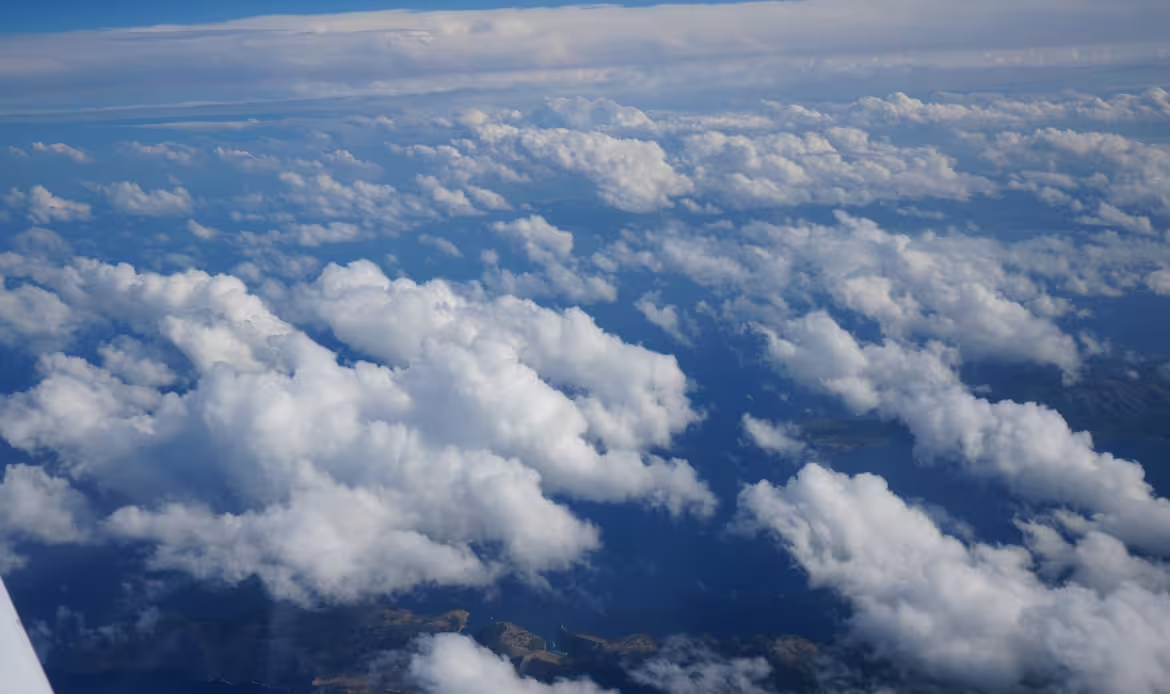
While I appreciate the convenience that VFR may provide in regions with good weather, flying low over the Mediterranean Sea or orbiting for 20 minutes while easyJet or Ryanair storm the place does not appeal to me. Despite the difficulties of the training, IFR allows for flying even into sunny regions, and while obtaining a SLOT is initially tough, it is in principle easy without parting way with half of your wallet.
Flying IFR
This was my third try at obtaining an IFR SLOT for Ibiza, and the previous two had been quite successful, so I didn’t expect much to change this time. I was concerned that the airport might be busier, but fortunately, it has more capacity outside of planned seasonal flights, allowing DJs and celebrities to arrive whenever they choose. More on this later, as I’d like to assist others in obtaining SLOTS in the somewhat unusual Spanish fashion.
Gota Fria & Thunderstorms
It’s worth noting that September is when you could fall victim to Gota Fria (Cold Drop) and encounter strong thunderstorms. So plans could change, but the weather appeared somewhat consistent for the week after our arrival. I had previously cancelled in August 2022 owing to a Mesoscale Convective System (MCS) which formed over the northern Balearic Islands during the night of August 17 to 18 and then quickly accelerated northeast, hitting Corsica early in the morning, killing 12 and injuring 116 across its path. This caused an intense derecho, which resulted in high winds.
I chose to fly an airline to save money on the accommodation, and the unusually warm Mediterranean water resulted in unpredictable weather near the conclusion of the Summer Season.
Fuel Endurance
With that in mind, I decided to make a fuel stop at Montpellier Airport in Southern France on each flight of this trip. The only way this route could be direct is with a strong tailwind, but that would require flying across the Pyrenees, and anything more than 30-35 knots is likely to cause turbulence or mountain waves.
Owing to experience, the optimum flight time is 5 hours and 30 minutes at 70% power with sufficient IFR reserves.
El Cheapo
In aviation, everything is costly. Finding something inexpensive is practically impossible, or so I thought. There is a Spanish legislation that states that if you contact one of the main Commercial Aviation Agents and request Servicio De Accompaniento (more on this here), you will be charged the minimum amount for the minibus between the aircraft and terminal each way.
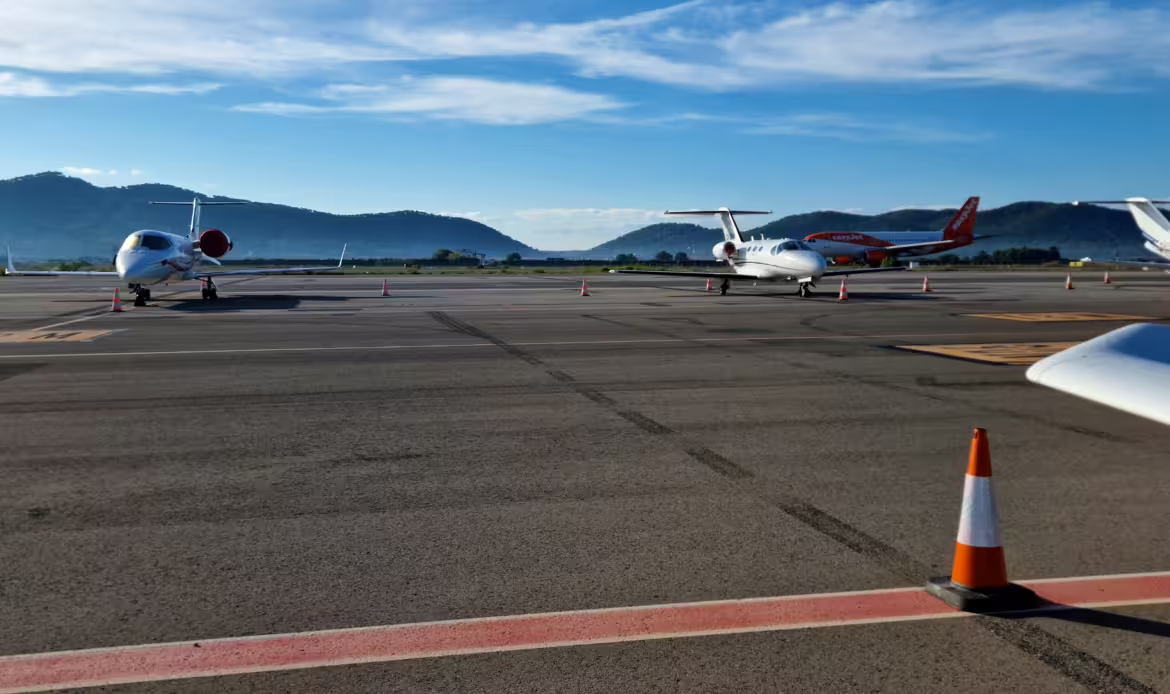
I contacted Iberia, who did not respond to my original email inquiry. After a few phone calls back and forth, I was able to organise this service and was emailed the bank account information where I would pay before service was guaranteed. They insisted that they would only supply the transfer – for everything else such as airport SLOTS, and refuelling, I would have to arrange on my own.
I have an AirBP card and, fortunately, located SCLA’s contact information on the website. When I called, I was instructed that I would need CONOS (traffic cones) of the required specification prescribed by AENA. This means either carrying these on the plane or hiring a “Proper Handler,” which costs anything upward of £500 in total at Ibiza.
As I discovered the previous year after an unsuccessful trip, I would have to contact AECFA for an IFR slot, which many aviation sites do not advocate because it is complicated and may irritate the airport. All GA/BA flights seeking to operate at Spanish airports designated as Coordinated must get a slot authorisation from the Slot Coordination Office in Aena beginning with the summer 2011 season. This practice affects Ibiza Airport. More on SLOT requests to follow soon.
Airport Choices –
Airport selection for IFR flights is based on several factors, including accessibility (customs and police), reasonable handling fees, and a new restriction: Category A aircraft are not accepted at the airport. This is not permitted at airports such as Barcelona El Prat, and in certain circumstances, while airports are not allowed to ban, they do so covertly, charging you exorbitant fees. Jet A1 availability is not an issue at most major international airports for the type of aircraft we operate.
Ibiza Airport – IBZ/LEIB –
There is only one airport on the Balearic Islands of Ibiza and Formentera, located 7 kilometres (4.3 miles) southwest of Ibiza Town, and it handled a record 8.9 million passengers in 2023. The islands are a popular destination for European tourists, featuring caves and beaches with crystal-clear waters this means the airport will be rather busy.
It contains customs and immigration services and operates 24 hours a day during the summer season.
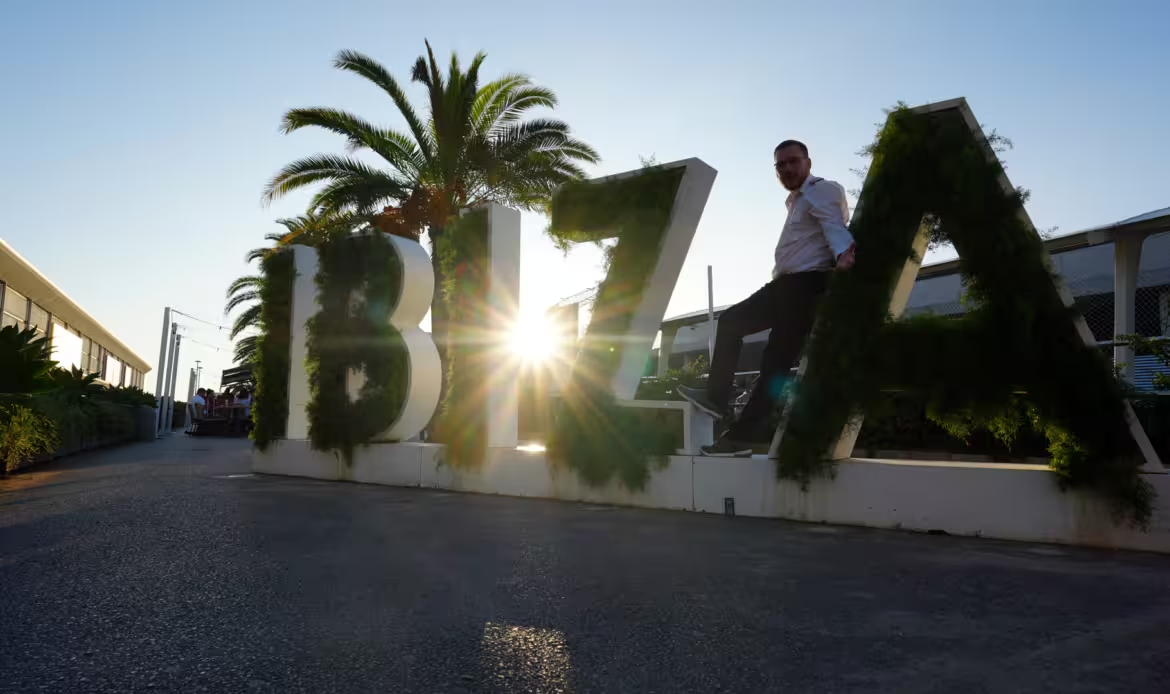
Handling/Airport Quotations –
When you choose the El Cheapo option, you will be responsible for organising and paying for several items. There are other things to coordinate, which typically cost hundreds of pounds – especially if you want to fly into the Island IFR.
AIP
Before you go on your trip, there are a few things you should research, and the greatest place to do so is the Spanish AIP. It is occasionally behind the curve and has not been updated, however it is regularly fixed.
Some airports will not allow you to follow this approach, but I’ll explain more in a later post – in theory, this should work at all airports. AD 2 – AERODROME DATA contains all of the necessary information and contact data.
Local rules usually specify the requirements. Access gate G3 from the General Aviation apron is limited to aircraft with a maximum wingspan of 18 m, inclusive. If you frequently need the Commercial Ramp, you will need to communicate with the General and Business Aviation Managers (FBO). The Ramp Agents are often the only ones who can attend GA using the El Cheapo service.
AENA Charges
In most cases, the initial step is to contact the airport directly. I wouldn’t call them because they only accept phone calls from the handler. Email is the most effective approach to negotiate the complexities of this situation.
You must send AENA the information of your intended travel. This comprises the callsign/registration, arrival and departure point (LFMT), and estimated time in UTC. Also, include your MTOW and noise certificate.
The title is “PRESUPUESTO” – These charges vary depending on aircraft type and MTOW/noise category.
It is worth noting that you have already contacted RAMP AGENT (i.e. Iberia) for service. How to pay these fees will be discussed later.
Alternatively, RATES and the PRICING SIMULATOR can be found here.
Iberia – Minivan service
All General Aviation and Business aircraft must contract ground handling services in accordance with AD 1.1 of the AIP for Spain. Whether you fly VFR or IFR (explained below), you must seek a handler.
I selected Iberia for this service, as they were the major agent in Ibiza, and were highly busy. More on this in the El Cheapo article, however while interacting with a RAMP Agent, you must request Servicio De Accompanimento or the minibus transfer from the aeroplane to the commercial airport. This was requested to Iberia via email at the time, and I had to follow up with a phone call or two to obtain the necessary information and confirm a service.
To make this process easier, get a name and include it in the email, as “FAO Amelia” – once confirmed and the payment was delivered, I printed the receipts in PDF format and on paper, so I had fewer hassles when I arrived. I of course accepted this transfer at a rate of 9.43 EURO each trip, for a total cost of 18.86 EURO, including IVA.
To generate an invoice, you must have an NIF or CIF number. A VAT number for a Limited Company you own or a flying group/club/school should suffice.
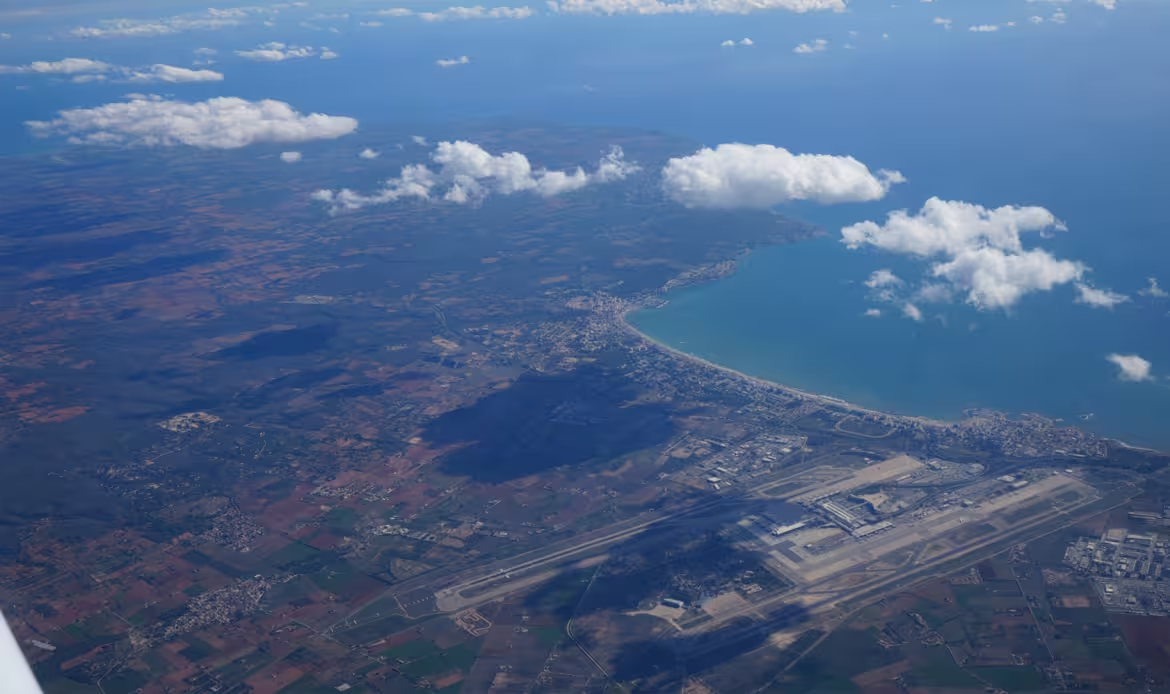
IFR SLOT
The most challenging aspect of this operation, and the major stumbling block, is the viability of flying into or out of El Cheapo, IFR. I appeared to have cracked the code for Ibiza, as all information was supplied on the website.
You’ll discover that the SLOT COORDINATOR only wants to deal with the handler, however, I was able to obtain the Ibiza Airport Coordinator’s contact so that you may follow up if necessary.
The contact details for AECFA are the following;
E-mail:
slots(at)aecfa.es (slot requests)
slot.coord.admin(at)aecfa.es (other issues)
Tel.: +34 91 393 77 50
Tel (Ibiza SLOT COORD) ++34 91 393 77 66
Example GA Request for GZANY
When sending the request, follow the guidelines below and include the wingspan, MTOW, and aircraft owner/billing information. When I had my failed effort in 2022, they appeared frustrated on the second request since I cancelled so the next time I came to request a new slot they wanted my billing information, so I now include it in all SLOT requests.
This must be completed no more than 15 days before your flight, as stated in the AIP for LEIB/IBZ.
Details of using the IATA SSIM format via email.
SCR
/REG
S23
12SEP
LEIB
NGZANY 22SEP 004DA40 MPL1530 D
NGZANY 28SEP 004DA40 0830MPL D
SI WINGSPAN 11.94M
SI AIRCRAFT TYPE DA40D 1150KG MTOW
SI ALTAIR AVIATION LTD
SI PRIVATE FLIGHT
SI +44xxxxxxxxxx
SI (1st Line of Address)
SI (City)
SI (Postal Code)
GI BRGDS ROBBIE
SLOT Received from AECFA
The 1530z SLOT was unavailable, so 1540z was suggested as a replacement. Include the GES number (RMK/) as ITEM 18 of the flight plan. Outside of office hours, it gets more difficult to alter SLOTS. Some AIPs provide the contact numbers of the local coordinating office, but I believe it is IBZ.GTR(at)aena.es.
You’ll see that the slot is to/from Montpellier (MPL/LFMT), which is the airport from where we will depart and arrive in IBZ (LEIB). This is not the time we are scheduled for Montpellier.
SCR
/GES4737082
S23
12SEP
IBZ
UGZANY 22SEP22SEP 0000500 004DA40 MPLMPL1530 D1
KGZANY 22SEP22SEP 0000500 004DA40 MPLMPL1540 D1
K GZANY 28SEP28SEP 0004000 004DA40 0830MPLMPL D1
GI END TELEX
GI BEST REGARDS RUBENSCLA refuel
Typically, the AIP will list the refuellers; however, if this is not the case, you can always contact AirBP or the relevant fuel provider for more information. In this case, I called SLCA but this required translation. They said I should phone them when I arrived and that I would need “CONOS” since they would not accept refuelling without it, according to the legislation.
SLCA
Email: ibz(at)slca.es
Phone: +34 971 80 91 72
Mobile: +34 699 48 94 32CONOS
CONOS is Spanish for cones, which appears to be a prerequisite for you to pay for “Proper Handler”
A.2.18. Cones must be placed on the ground around certain parts of the aircraft with the
aim to prevent damages incurred by vehicles or teams during handling
operations. In the case of strong winds, necessary measures will be taken to
avoid these cones becoming FODs.
You can find the Apron Safety rules on the Apron Safety guidelines from the AENA website. Which states the following criterion; some areas require it, some do not; nonetheless, in Girona, Iberia offered it, and in Ibiza, only “Proper Handler” could supply it. So we had to do the easy thing: get some traffic cones.
There are no right or wrong solutions, although the majority of the aviation sector employs orange/red reflective cones with 750mm height. The following are reasonably priced and weigh 4kg each, so keep in mind that the total weight is 16kg, and they are fairly bulky (the size of a large suitcase) when compacted together, which may throw a wrench in your planning if space is limited or useful load is restricted.
750mm 1-Piece Traffic Cone | UK’s No1 Supplier for Road Cones | SSUK (streetsolutionsuk.co.uk)
Tech Stop in Montpellier–Méditerranée –
I’ve looked at two potential destinations in Southern France that appear to be rather popular among Euro Tourers. Beziers is one, but Montpellier appears to be an H24 airport. While there were some strange restrictions on PPR for non-based aircraft, it was nevertheless possible to email them on short notice and request a fast tech stop.
A3594/23 NOTAMN
Q) LFMM/QMKLT/IV/M /A /000/999/4335N00358E005
A) LFMT B) 2306291533 C) 2310282359
E) PARKING LIMITED FOR ANY NON BASED AND NON REGULAR ACFT :
REQUEST TO BE TRANSMITTED UPON 3 DAYS PPR BY EMAIL TO :
PCE(AT)MONTPELLIER.AEROPORT.FR
CREATED: 29 Jun 2023 15:33:00
SOURCE: EUECYIYNI had used Montpellier in August for a tech stop in both directions, on the way to/from Italy due to weather over the Alps. The fee comes as a FORFAIT JOURNÉE ET JOUR SUPPLÉMENTAIRES/ DAYS PACKAGES and totals EUR 29.28 (£25.95) for both movements in and out. All arranged via pce(at)montpellier.aeroport.fr
JetA1 can be paid via a Debit Card or TOTAL Card.
Accommodation –
This was a somewhat late booking, and because of the high medical bills I had the previous month, I wanted to budget and guarantee that I could afford the vacation. With that in mind, I wanted All Inclusive so I could eat and drink to my heart’s content. Unfortunately, my research was not thorough, but there was a fairly priced hotel on Booking.com with free cancellation (72 hours). The pricing kept changing, and I hadn’t received my medical yet, but it was expected to be processed shortly, so we booked under the assumption that it would be certified for this trip.
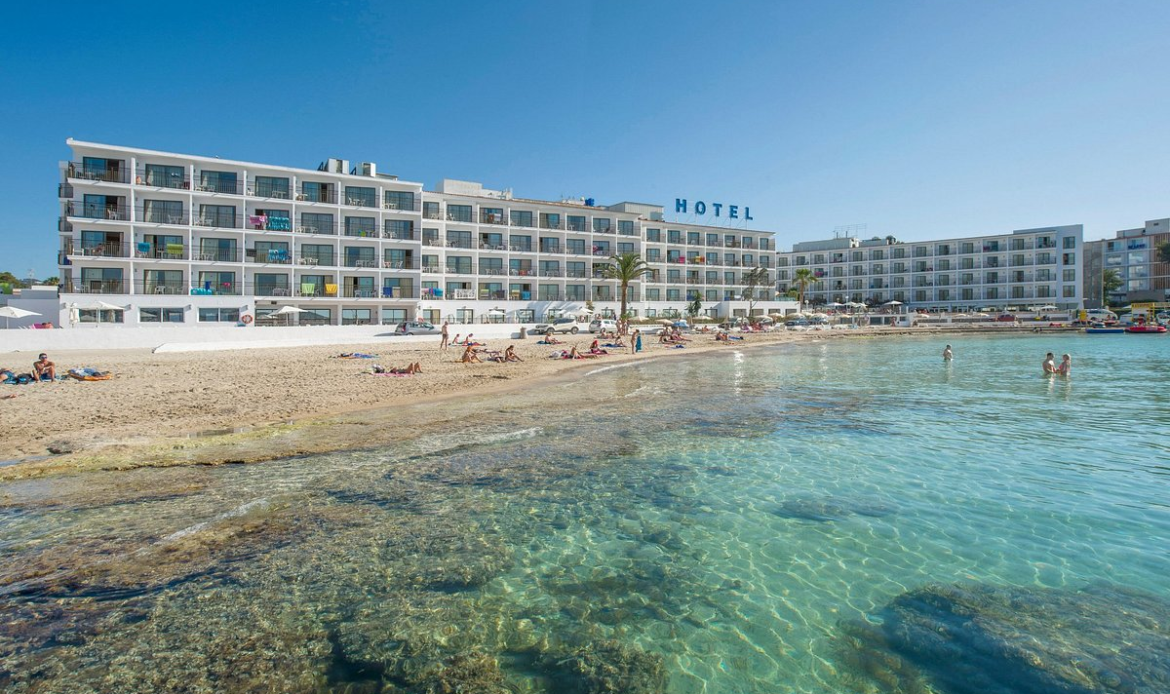
We chose Hotel Vibra S’Estanyol because it is ideally located in San Antonio Bay, and Ibiza Airport is less than 20 kilometres away, with bus service nearby. The total cost for five nights, all-inclusive, was 947.55 EURO, or £405 per person. We also observed that the £2 bus from the airport stopped fairly close, which influenced our decision, and most of our friends would be staying nearby.
We later decided to spend an extra night due to an event on Tuesday evening finishing Wednesday morning. This increased from £421.51 to £483.73 total per person, a minor increase due to the extra night.
It should be mentioned that from July 2016, there has been a tourist tax. The HOTEL will offer that rate to the guest upon arrival, and payment must be made in full by the guest since it is not deducted from the booking cost. This is now €2.20 per person per night, in addition to the booking fee.
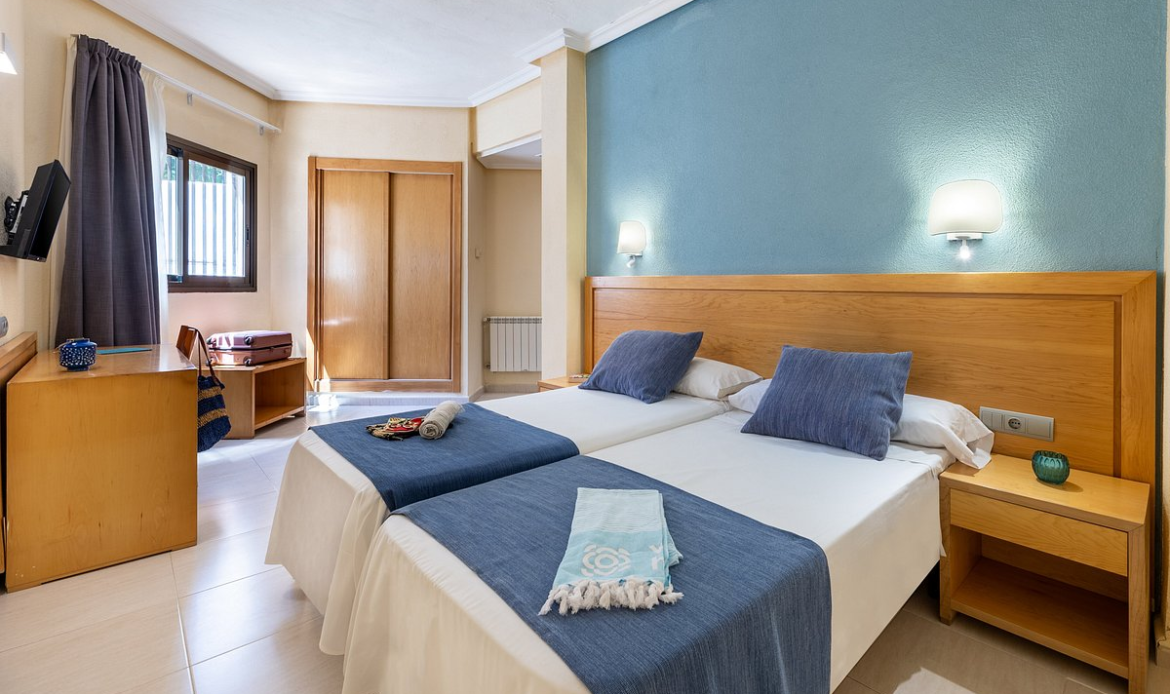
Where you stay in Ibiza is totally up to you; both Playa D’en Bossa and San Antoni have nightclubs and decent bars nearby, but either would suffice as a base. If clubbing is not your thing, other parts of the island, such as Santa Eulalia and Ibiza Town, have something else to offer.
The island has more to offer than simply parties; explore the local cuisine, the 50+ coves and beaches, or any of the island’s water activities. There are numerous great dining alternatives in Michelin-starred restaurants, as well as stunning buildings to admire.
Without a doubt, the most comprehensive source for information is Ibiza Spotlight
Weather Forecast –
The FAX charts for the morning of the trip indicated different frontal systems linked with the tail end of ex-Hurricane Lee, with Ex-Nigel close behind approximately 1000 miles. It didn’t look promising, with a line of pretty severe precipitation anticipated from Bilbao to Le Touquet linked to CBs. There were two, maybe three, options: fly very early east of the weather down to Montpellier, wait and fly behind the front and get in Ibiza after sunset, which I was not overly interested in, or cancel for the fourth time.
So, with the TAF checked, persistent mist, rain showers building, and a hurried getaway are required to beat the front as it advances eastward. This was an intricate Met setup, but we anticipated we’d face difficulties getting there.
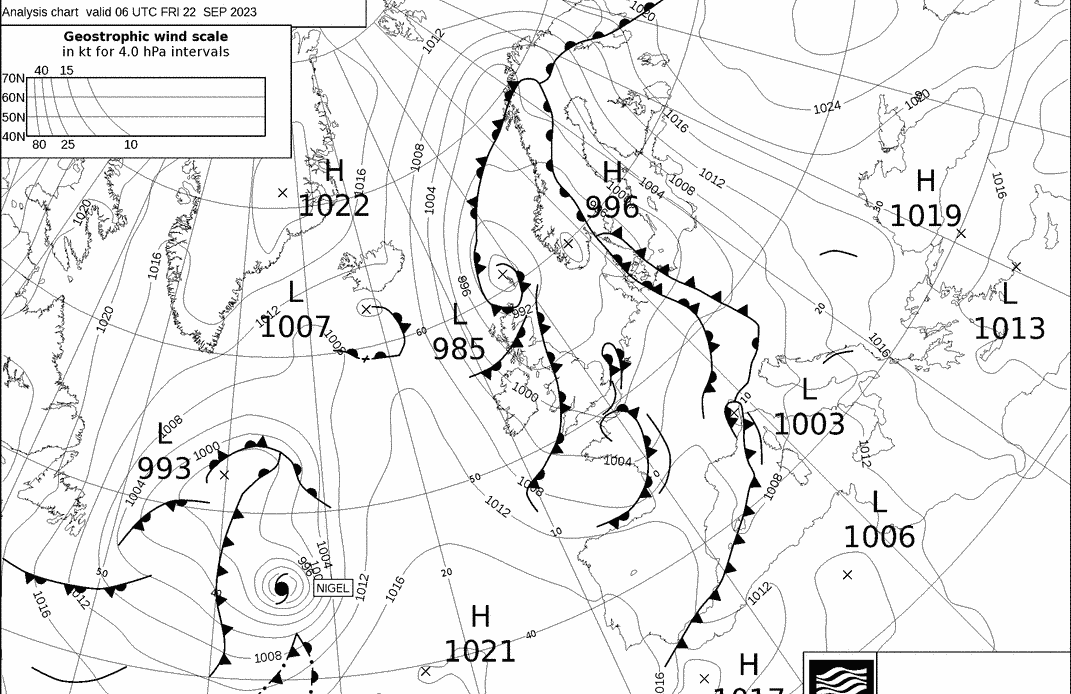
TAF EGSS 220500Z 2206/2312 26005KT 3000 BR FEW008 BECMG 2206/2208 9999 NSW TEMPO 2213/2218 6000 SHRA PROB30 TEMPO 2214/2217 28015G25KT 4000 +SHRA PROB30 TEMPO 2218/2220 8000 -SHRA BECMG 2302/2305 BKN010 TEMPO 2305/2310 BKN007 BECMG 2310/2312 SCT030=
TAF for London, Montpellier & Ibiza on 23rd of September
TAF AMD LFMT 220244Z 2203/2303 28010KT 9999 FEW030 BKN070 TEMPO 2203/2205 RA SCT030 BKN040 FEW045CB BECMG 2206/2208 CAVOK=
TAF LEIB 220200Z 2203/2303 28010KT 9999 SCT020 TX27/2213Z TN19/2205Z PROB30 TEMPO 2205/2210 4000 SHRA SCT040TCU BKN050 BECMG 2209/2211 34006KT=
It was evident that the cold front that had swept across the Mediterranean Sea would pass fast, and there might be a few thunderstorms in the distance as we crossed the Med, but the forecast was favourable, and the weather would clear up nicely as we approached Ibiza.
Unfortunately, the cold front predicted heavy winds, so a long trip from Montpellier to Ibiza was scheduled and planned.
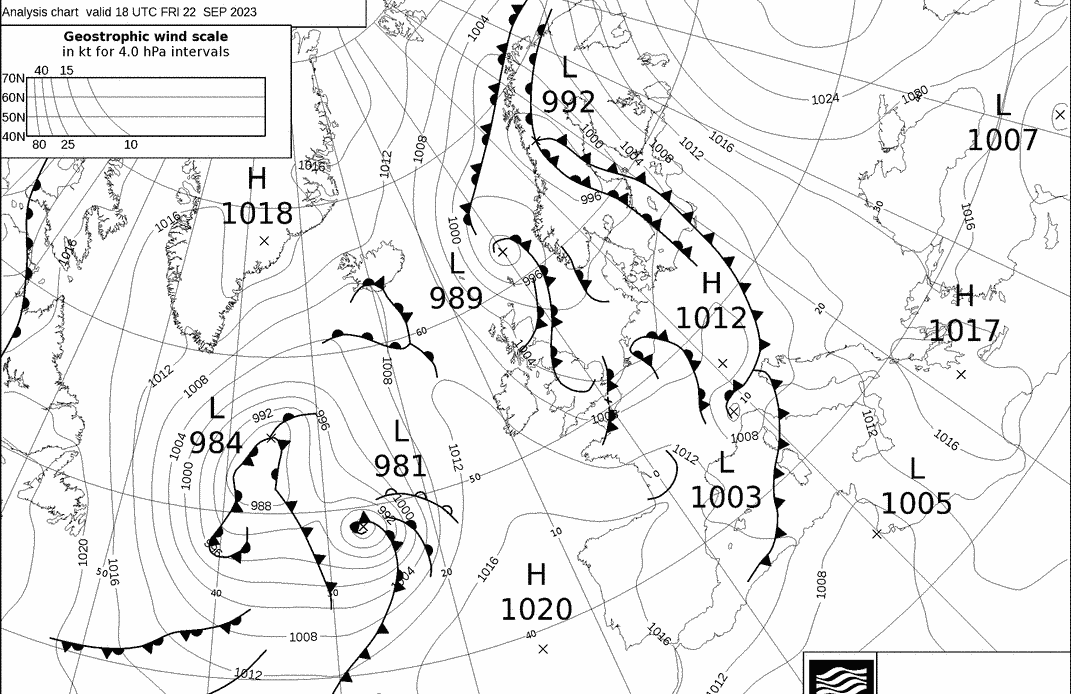
So far, September’s weather has been generally calm, with high pressure affecting the UK’s weather in the first half of the month, delivering fine, sunny, dry conditions and the most substantial stretch of warmth since June. The middle of the month witnessed a sudden shift to considerably more unsettled and autumnal weather, with westerly winds bringing Atlantic low-pressure systems and heavy rain.
This concerned me because the aircraft’s capabilities required me to consider the weather, and the flight(s) home would almost certainly be difficult.
Change of Plan –
This is the second trip in a row where a change of plans was necessary. At least this time, the aircraft was scheduled to depart slightly earlier than expected, and I needed to keep options in mind, such as landing later (diverting into Oxford, Southend, or Biggin Hill) or taking an extra day’s leave and landing early in the morning. These are the possibilities I had to consider for the return.
As I mentioned in my previous write-up while the DA40 is a capable aircraft, FL160 can be achieved (as I proved on the way to Slovakia). However, it cannot outclimb severe weather, such as thunderstorms or severe turbulence. Even if you manage to safely navigate through that weather, there is an ever-growing threat of icing conditions, which the aircraft cannot prevent.
We initially planned a route through Le Harve, Le Manes, and west of Limoges. This was the route I flew in August, and it was the shortest flying time, but the night before, the weather forecast looked like a wall that I probably couldn’t overcome.
N0130F150 LAM L10 DVR M189 WAFFU DCT SITET A34 LGL J55 RONAX/N0130F100 J55 GINON/N0125F130 DCT ETPIL/N0128F130 DCT PI DCT ADABI DCT LMG G36 LAVRA DCT NARAK DCT AMOLO G39 AFRIC G393 BRUSC BRUSC6T
Option A
So I considered various routes, such as a 5-hour trip east of Paris down to Lyon and then into Montpellier from the northeast, which would be somewhat longer but let me ride ahead of the front and potentially avoid some storms as we fly south through clear air. Option B takes you down below via RINTI.
There were other options, such as routing via CPT and then to the east of the Channel Islands down to Montpellier, which, while longer, would be preferable to route through bad weather – but the best option was to head east and early, which was the flight plan for Montpellier.
Flight to Montpellier –
With a 1530z slot into Ibiza reserved the week before, the lack of tailwinds resulted in a 5-hour flight to southern France for refuelling. There was also the added pressure of the weather on either side of our route; I might have used more time in the day or a later SLOT. September is peak storm season, so the Atlantic can and will always throw a curveball.
So, with that in mind, I chose to depart around 0550z, getting airborne by 7 a.m. local. Similarly to the previous departure to Bologna last month, the sun was hardly visible above the gloomy sky ahead.
A potential source of concern was the low-level mist that formed as we prepared the aircraft for the long journey ahead, parked near the runway to reduce noise on the airfield in the early hours. We had to get a move on, as I had discussed with my instructor on the group the day before whether the best option was west of Paris or east of Paris, however, my initial thoughts were on flying east but had to put on our skates because the weather was moving extremely quickly, but we would be moving 100mph faster, allowing us to avoid most of the weather on our route down to Montpellier.
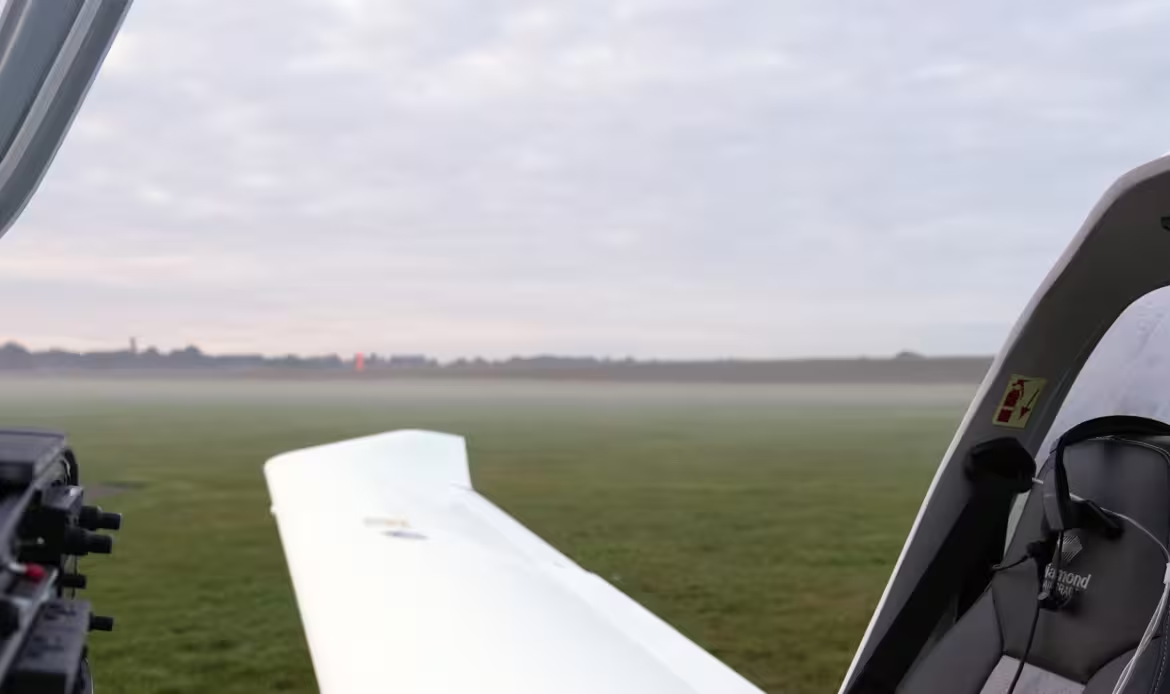
Lots of moisture began to develop on the airframe; after all, it was quickly reaching the depths of Autumn, and with it, the ever-increasing threat of early morning mist and fog connected with the adjacent frontal systems. Because of the recent heavy rain and a very heavy aeroplane full of fuel, it took a while to get rolling, and we departed over 15 minutes late, which was due in part to us having breakfast at McDonalds before the trip.
Once we had gotten the aircraft going, we taxied over to the power run-up area near Runway 03L to finish our power checks. After that, we did a quick update of the radar data to see if anything was lurking when we were low-level, and everything looked clear until we reached the French coast.
We lined up on runway 03L and began our extremely long take-off roll, owing to the pretty soggy grass from the constant bombardment of rain we’ve had since late May; we eventually got airborne and soared away into the rising light using the noise abatement method. Because there would be no traffic at this time, I called up Thames Director and was eventually able to climb into restricted airspace.
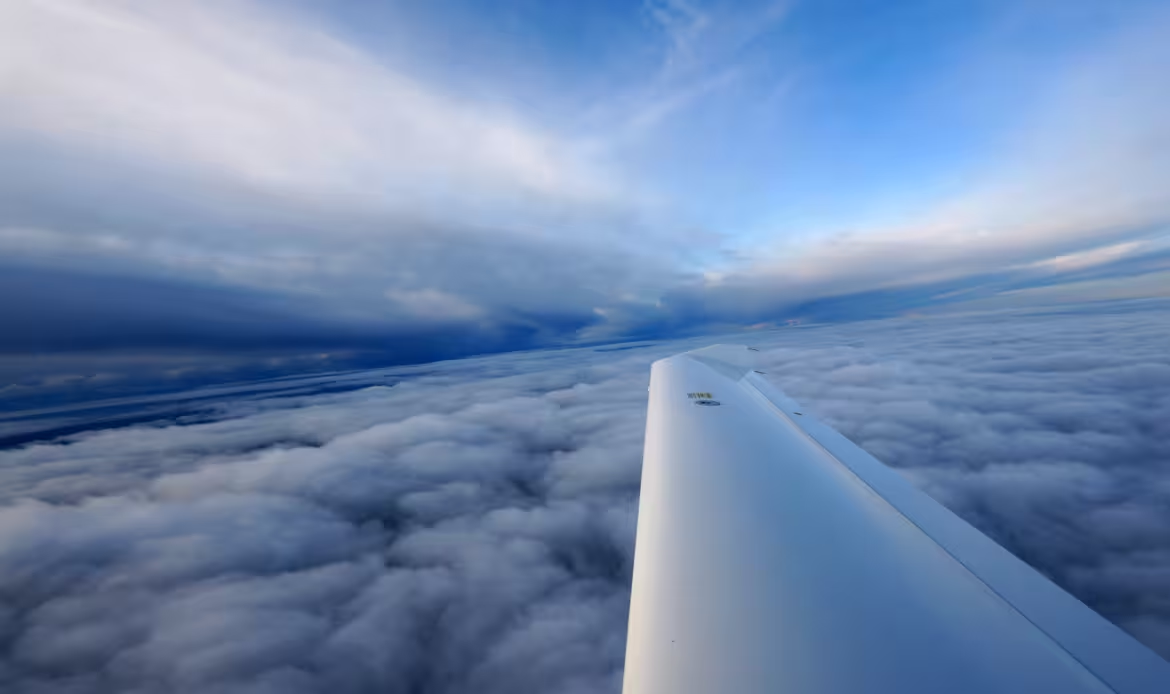
There was a mid-level thin layer of cloud above us, most likely from the approaching frontal system, and we could see the weather ahead around Le Touquet/Calais and reaching for kilometres to the west, which was linked with ex-tropical weather at the tail end of ex-Hurricane Lee.
Once we were above the first layer of cloud, we could see the anvils ahead and any gaps. Unfortunately, the heading I negotiated with London put us 12NM from the airway and very near to entering the Brussels FIR, which I didn’t expect to be an issue – but it was because we hadn’t been filed into that FIR and had to be arranged with ATC. This meant that London had no choice but to inform us that we would have to wait until we were cleared past the weather, which was heading at about 15 knots towards our planned flight route.
As we approached, I noticed that at FL130, we would be under the Anvil and extremely near to the weather; interestingly, we were handled to Lille Approach, who changed our squawk and then swiftly returned to Paris as we changed our heading to remain in French airspace by 366 meters. Surprisingly, the flying conditions were pretty calm as we went under the Anvil of a CB concentrated on the Le Touquet area. This was a heart-racing moment, not because of the weather, but because we were on the verge of becoming stuck or having to push through the weather.
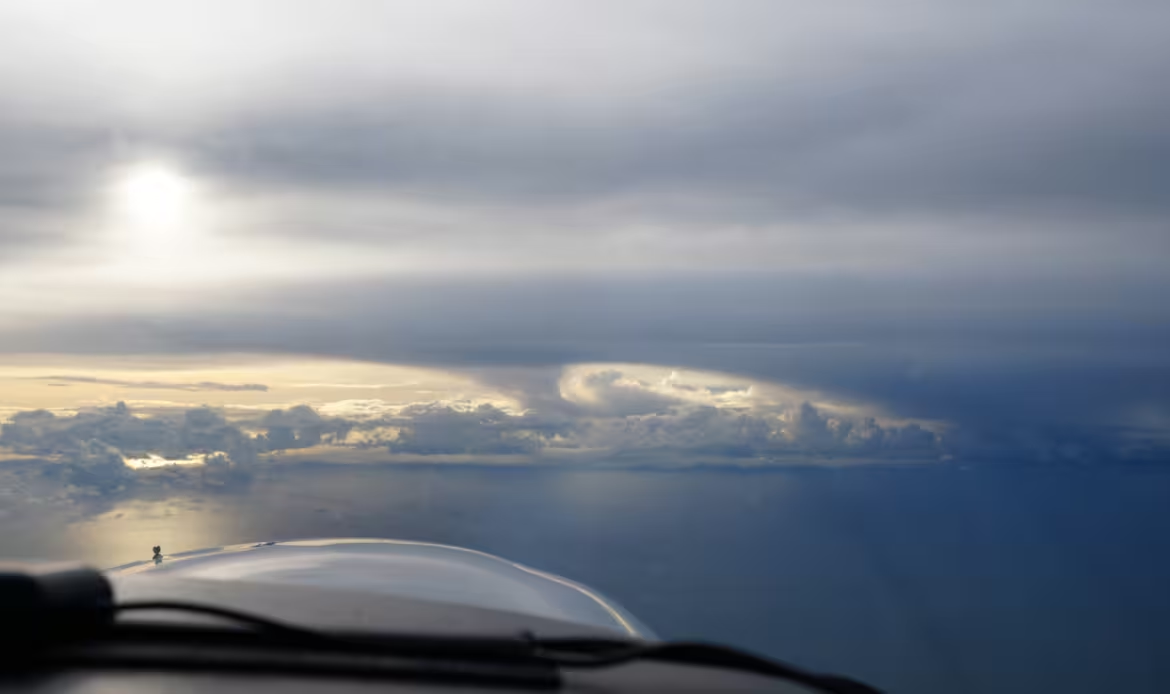
We could climb, but I’m not sure whether we could have outclimbed the weather to make things simpler for ourselves. We were able to make a right turn directly to waypoint BILGO after clearing the Anvil thrown by the wind into our flight path.
Things calmed down briefly, but ahead in the distance were the tops of more cells, so we decided to climb to FL150 to try to get over the storm. These were entirely related to the occlusion and trough to our west, which moved eastward towards us. We were caught between this and a cold front that had caused massive thunderstorms across mainland Spain and Southern France overnight.
I could have climbed to FL160, but I didn’t see the point; I could see the ground through the thin layer of weather, and it was intermittently clearing every now and then, indicating that these were the very tops of the approaching wall of CBs to our west, and the ride was relatively smooth.
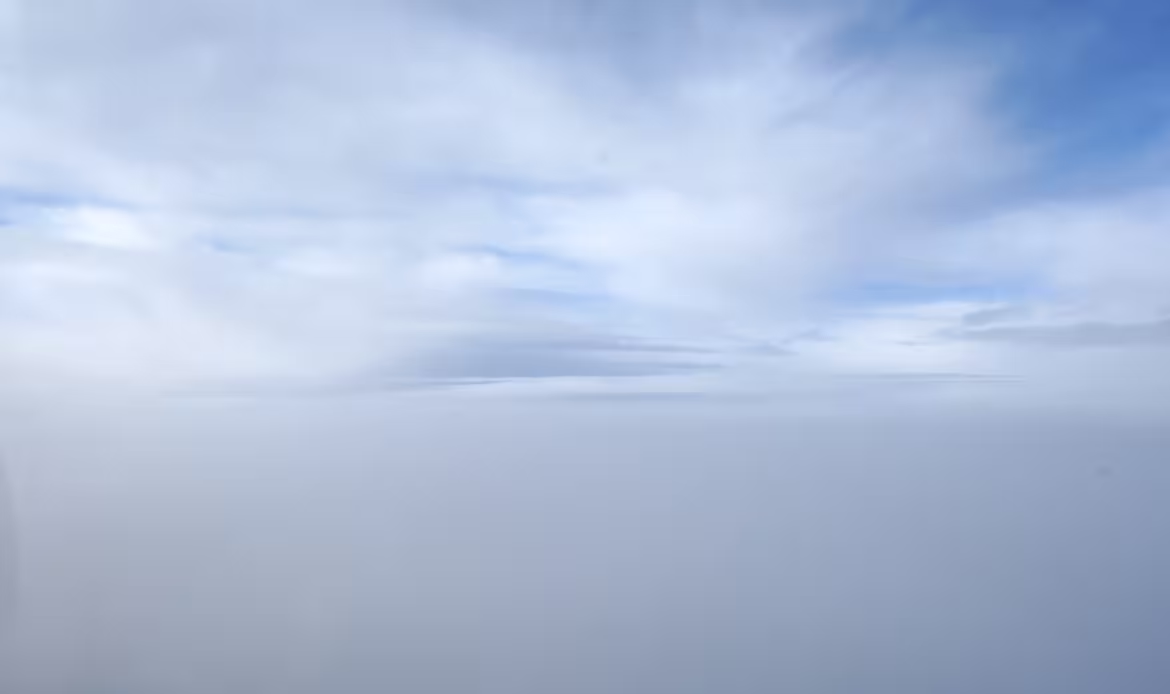
The outside air temperature was -12°C, so the chance of ice was low, but we would continue to check; interestingly, there was visible precipitation, but it did not affect us. I probably wouldn’t have needed to observe as closely as I did, but it was better to be cautious than sorry. With low terrain underneath us and uncontrolled airspace, we had options.
Things began to clear, but soon ahead of us was an even larger anvil, so I chose to come slightly to the left and requested a deviation from Paris because the bottom section of the anvil was darker than what we had just flown through. The option of FL160 remained, but it wasn’t long before we could make some more turns to the right and eventually in clearer air, as flying at 150mph against the front at 20mph meant we were finally beating it to our target.
We discussed between us and decided that we would probably avoid anything that appeared ominous and monitor the development with Golze system updates. Paris ATC is always helpful, and at these altitudes, there isn’t much air traffic except CDG arrivals flying above and through our level.
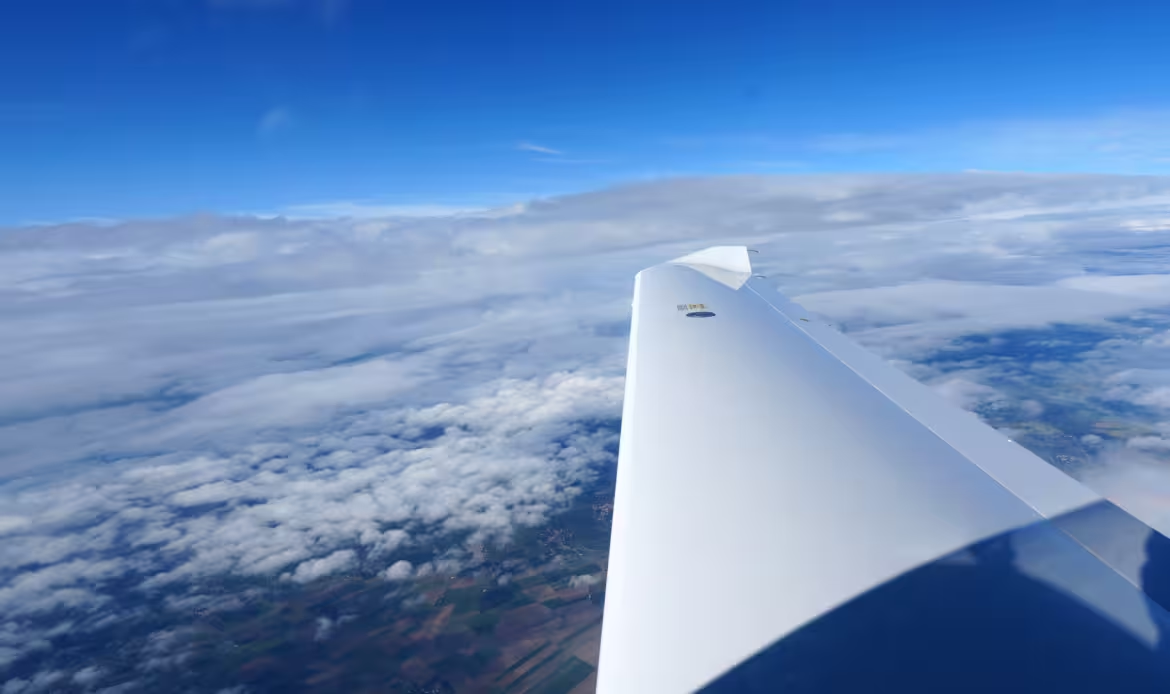
The risk was acceptable because we had a backup plan and were content to go into southern France with minor changes as the front approached from the west. We did pick up some little icing in heavier portions of IMC, but there was no substantial speed loss, which is a common indicator that you’re going to have an issue soon. The sun shining down on us helped melt the minor ice on the wings as we flew towards Lyon.
With some additional deviations required, it began to warm up as we travelled further south. Not only did the air become warmer as we flew south, but the heat of the sun began to warm the sky, raising my concerns about the possibility of more ice in the clouds ahead. We made an initial descent when we passed Troyes due to the possibility of icing.
As we approached Lyon, additional deviations were required, but this time ATC requested due to traffic and a few route changes to shorten the flight duration even further. As we progressed towards the south, it became clear that the trip time would most certainly remain 5 hours. A further descent was required on the approach to Lyon, followed by another descent as we began to pick up ice in the cloud; despite the significance, we elected to descend to remain VMC.
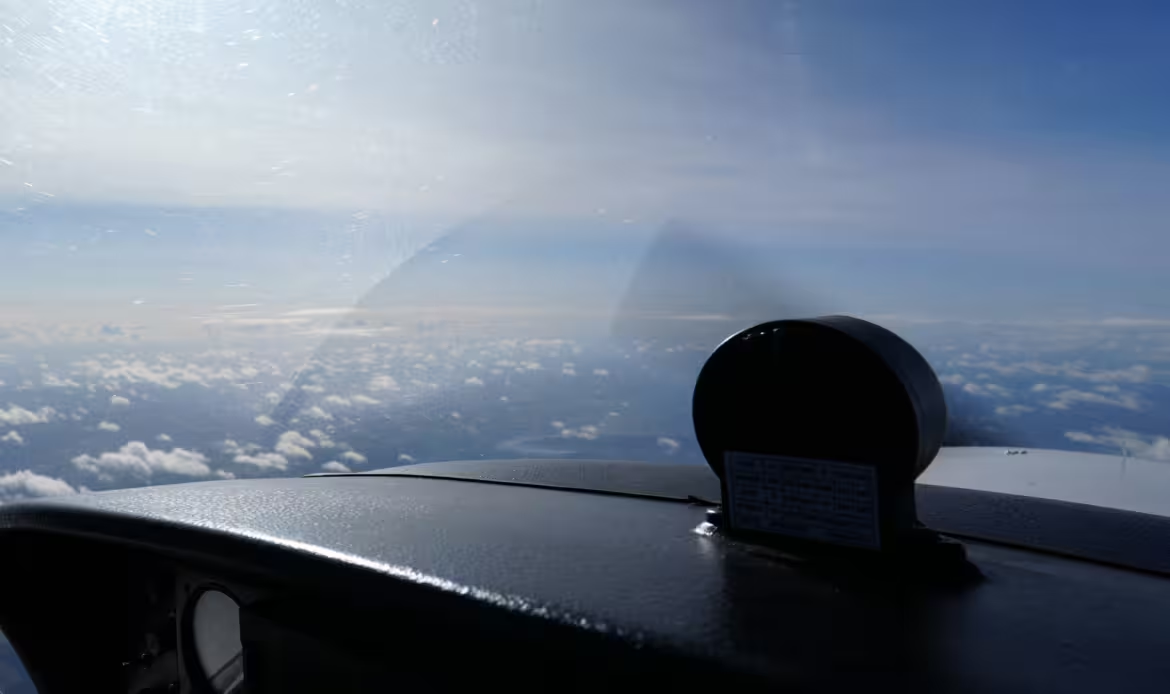
We also noticed some lenticular, which appeared to be coming from the MASSIF central. I’ve flown this route previously, and the lenticular pattern appears to be fairly typical, but turbulence appears to be scarce in this area, so I avoid it whenever possible. The last time I flew this route was in a very weak Mistral wind on my way to and from Bologna.
As we approached Nimes, we were handed over to Marseille, who then handed us over to Montpellier for the descent. Montpellier ATC gave us descent and a direct route to OSLUT, where we performed a LOC DME into Runway 30R because the glide path was unserviceable, as specified in the NOTAM.
We encountered considerable turbulence as we descended into the atmospheric boundary layer; this occurs on occasion at the same height and is particularly evident in a light aircraft due to the rates at which climb and descent are achieved. When climbing through this, the air generally smoothed out and visibility increases; below, however, considerable wind variations and thermal turbulence occur. This is not always the case, although the depth might range from a few meters to many kilometres depending on the local climatology.
We conducted the LOC DME into Runway 30R, and as we approached the final, we noticed a Volotea Airbus establishing behind us that we had heard on the approach earlier. We made a firm touchdown before leaving the runway for the short taxi to stand F2. I don’t recall ever performing a soft touchdown into Montpellier, which could be due to the local climate.
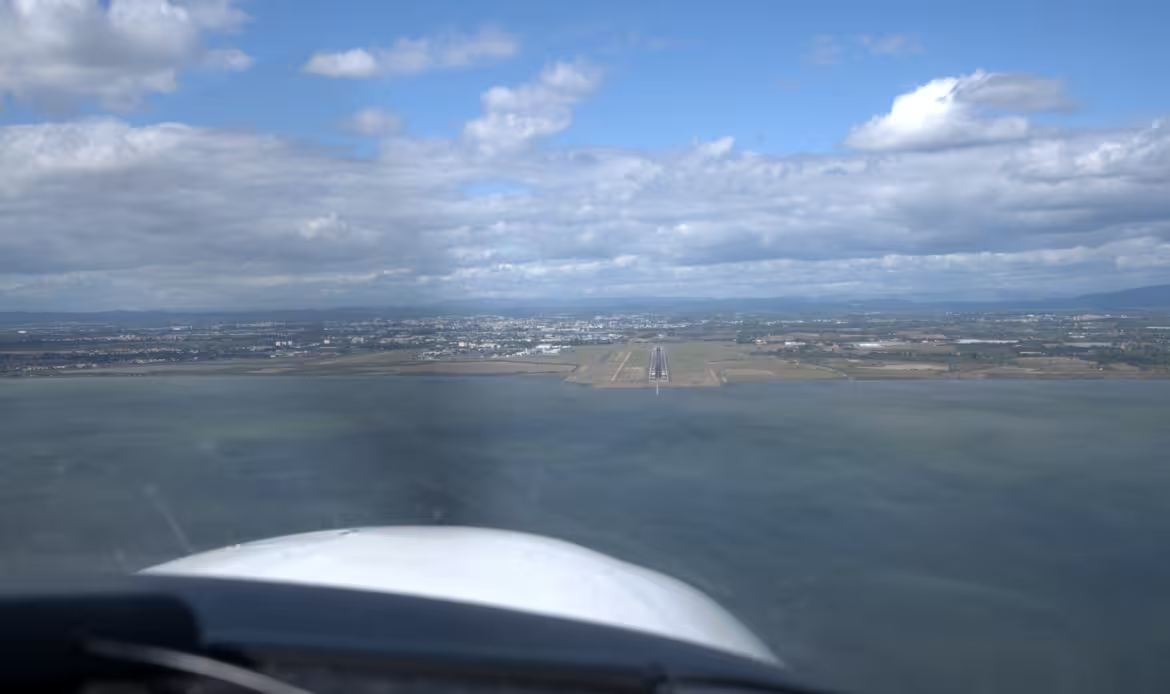
As we stopped on the stand, the refueller appeared and delivered very dismal news. Without the TOTAL card, we’d have to pay in cash, and I wasn’t sure if this was due to a recent change or if the machine was malfunctioning; my French wasn’t great, and I needed to find an ATM as soon as possible. He told us to go to the passenger terminal, which we did.
This was frustrating because it increased our turnaround time by 10-15 minutes, but we had no alternative but to trek to the GA terminal and then to the main terminal. The walk from the Foxtrot Ramp to the GA terminal is 200 meters, and the main passenger terminal is another 100 meters. While extending our legs was greatly appreciated, we had already used up all of our extra time and were pressed for time to meet the Ibiza SLOT based solely on flight time.
I went to get money, but it was almost insufficient to pay for the already refuelled aircraft. I luckily had some spare cash to pay for beverages in the bars, but it was quickly depleted due to the need to pay fuel fees. Once this was addressed, and I’d lost some money because they didn’t have any change, I didn’t care and just wanted to get airborne and fly to Ibiza.
ATC Flight plan and route flown –
N0130F110 LAM L10 RINTI/N0126F130 B3 VATRI/N0128F130 G40 ARSIL B13 SOMDA A6 LUXAN/N0128F090 A6 ROMAM/N0124F090 B16 MTL DCT MOLEN DCT NG
Filed ATC flight plan for EGSG-LFMT
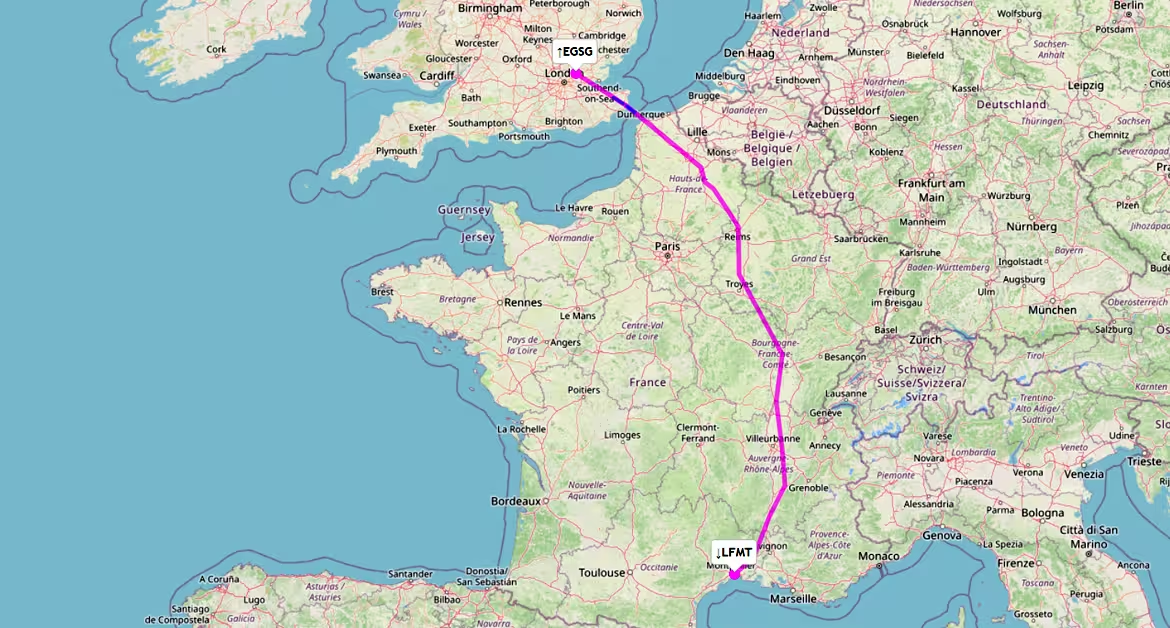
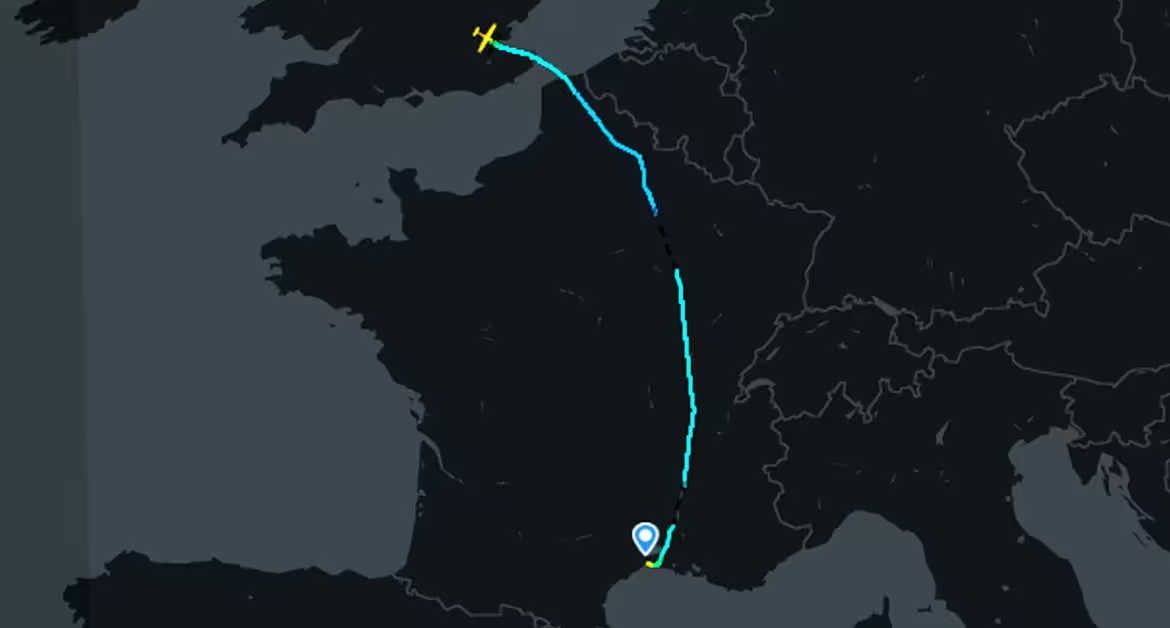
Flight to Ibiza –
We’d landed at 1315 local time and were supposed to be airborne by 1400. This was a rather brief interval, made even shorter by the fact that we had to pay for the refuelling in cash, which was something I’d never experienced at an airport, let alone an international one.
We were taxing out for departure in one hour; I’m not Ryanair, but a 15-minute delay isn’t bad. After a quick turnaround due to some issues, we got airborne to try to make our 1540z SLOT for Ibiza, and after a short taxi to 30R, we were on our way, getting airborne at 1220z, 15 minutes later than planned.
After a pretty early left turn, we climbed up to our initial level of FL100 and were promised FL130 and the possibility of a shortcut direct to Ibiza, which never materialised. The Palma TMA is one of the busiest in the world, with Barcelona to its north and the Balearic Islands near capacity; at our level, this was unlikely.
We were given a small shortcut but had to change course due to some rising convection, which, while not particularly large, was increasing as the warmest portion of the day approached. ATC sent us to Barcelona Radar, which we couldn’t hear due to our altitude and the Pyrenees’ orographic effects. I doubt there is much traffic conversing with Barcelona Radar at this flying height and distance.
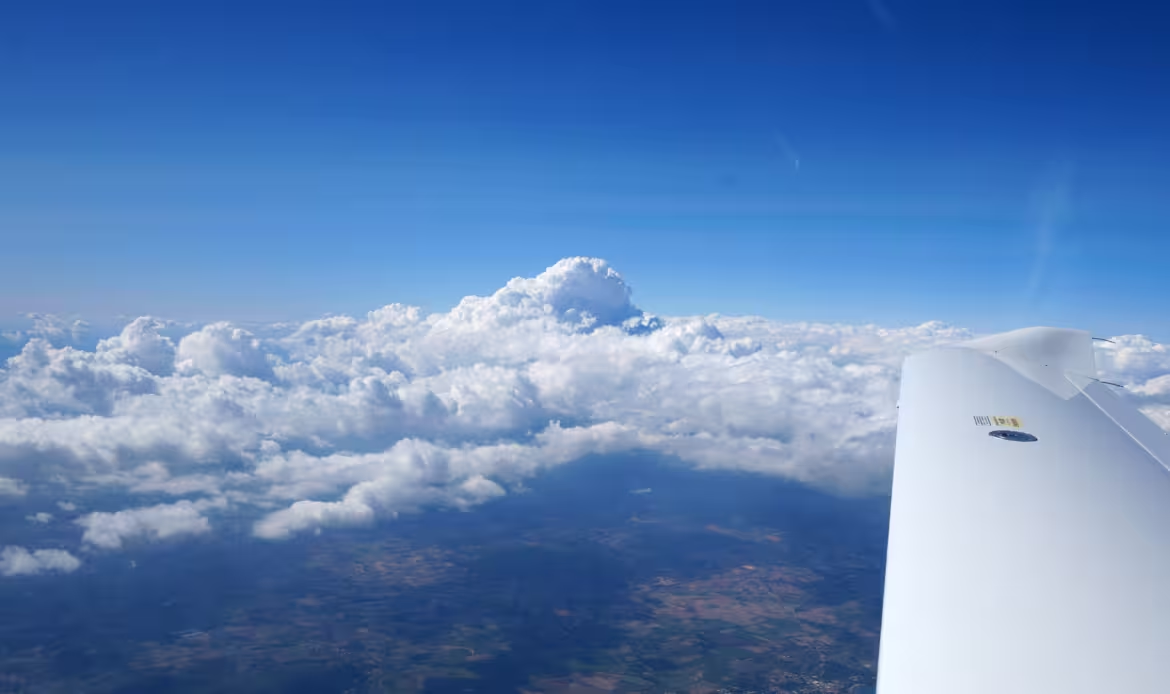
We had to return to Marseille Control to see if they had given us the correct frequency; we returned and it began to work, but I had to control the squelch to read them until we were closer to Barcelona; with no shortcuts provided, we continued to Bagur (BGR) VOR before making the longest crossing of water I’d ever done, routing airway N855 to Mallorca.
When I passed Girona, I realised that my preparation flight to Spain was finally coming to fulfilment, and I remembered landing in Girona for my sole night landing in the preceding few years. Checking temps and pressures like a hawk, but also nibbling into a Tesco Meal Deal, a late lunch by my watch, but to see us over until we could eat dinner in Ibiza.
A massive crossing loomed ahead of us, and any shortcuts, however unlikely, would require at least 118 nautical miles of water. Although you want to take every precaution possible, such as an ELT, a life raft, and lifejackets, it’s probably worth noting that with every flight comes the risk of an engine failure; it’s just aviation, and you should be aware of the risks; you can mitigate them, but you can also be more aware before they happen, giving you more time.
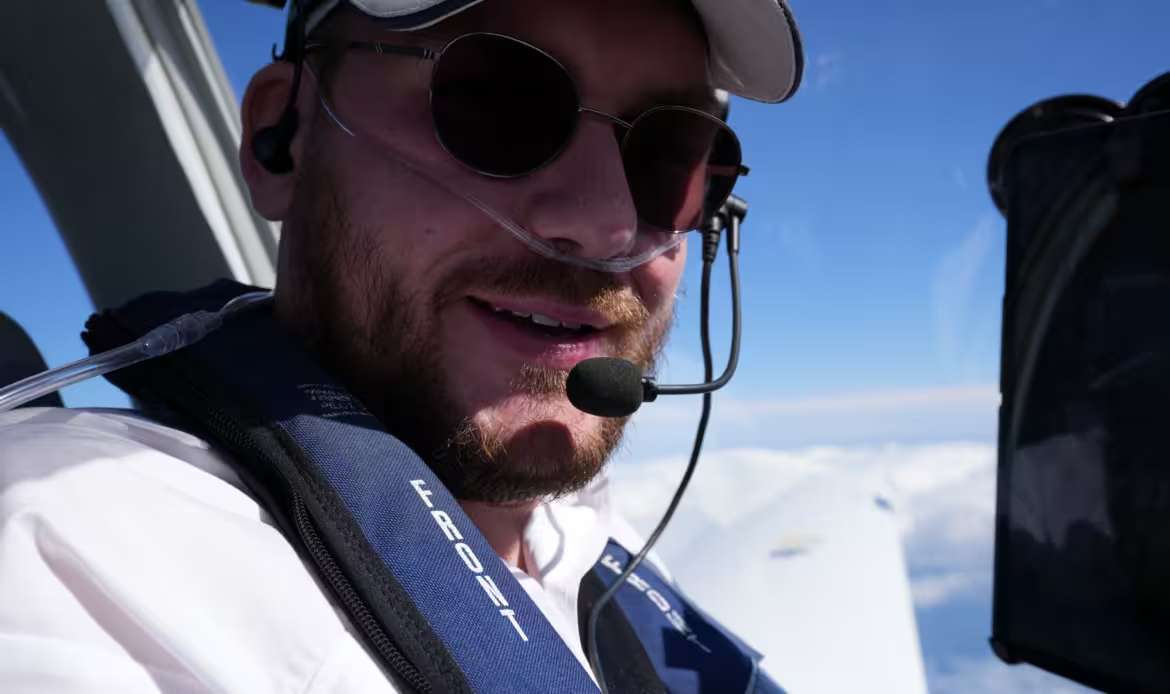
On a flight, I am constantly aware of how much fuel we have, as well as engine temperatures and pressures, supplemental oxygen onboard, and my personal SATS levels; this is especially critical for long water crossings where peak performance is required. This is slightly longer than crossing from Clacton to the Dutch coast, although water temperatures are more bearable in the Mediterranean Sea than in the North Sea, the aircraft is unaware of this, so the worst-case scenario is an unexpected one, either over mountainous terrain or over the North Sea.
After several encounters with Barcelona arrivals being vectored around us as we crossed towards Majorca, the island began to appear. The crossing would be relatively quick, maybe 55 minutes with weaker winds than forecast, we were making good progress and expected to land ahead of schedule – an unusual encounter, but a positive ending.
The cold front that had cleared into the Mediterranean Sea this morning was visible in the distance to our left, forming a wall that stretched from northeast to southwest. This had a noticeable impact on the Balearics this morning, but it was not significant; nonetheless, this cold front did however produce some major storms in Corsica and Sardinia later that evening.
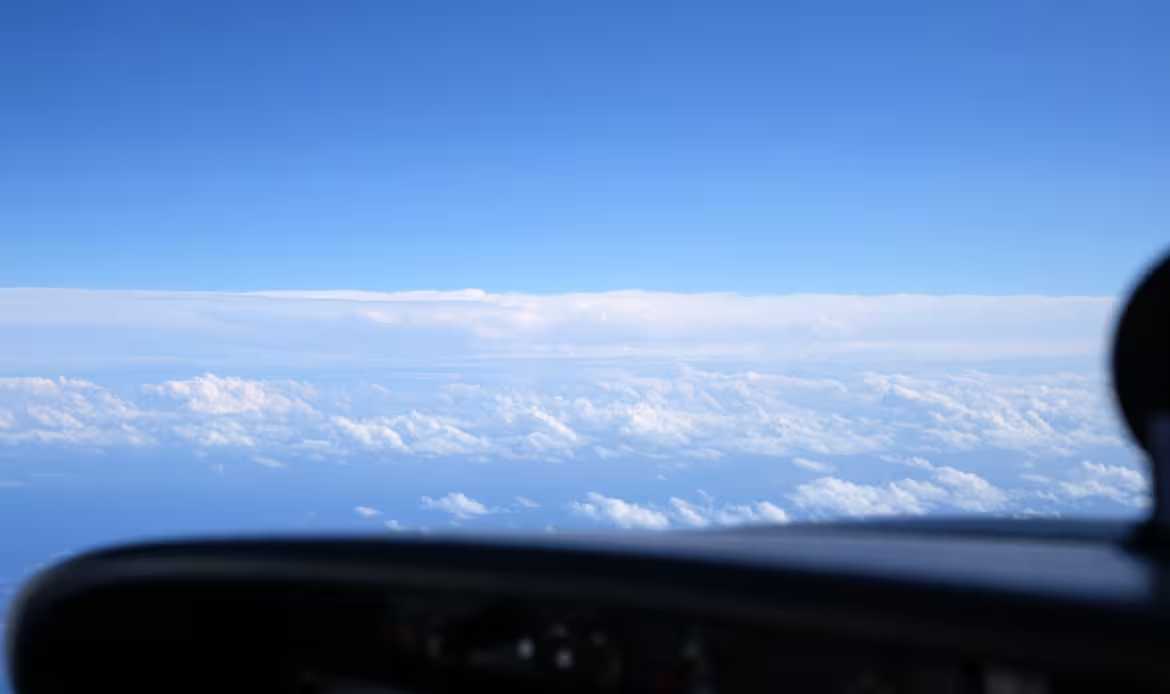
About 3 or 4 different controllers advised us that Runway 24 is in use in Ibiza; by the second time, we realised that nothing had changed, but the controllers appear to be quite helpful, and I am sure the climate in the Balearic Sea is one of the changeable runways due to variable winds. I seem to recall being in the nearby beach club Ushuaia in 2015 when the runway changed three or four times in one evening.
Spanish ATC can speak quickly, especially in the congested Palma TMA, and we were given a random waypoint that was not in our navigator at the time, which made things challenging. We eventually found it after it was spelt out to me, and it was on our STAR.
This brought us much closer to the mountain than following the STAR, but it also provided us with a beautiful view of Palma and Palma De Mallorca airport, which was surprisingly quiet, and I suspect this is because there are far fewer flights in the autumn months than in July/August when temperatures are lower and fewer people are on vacation.
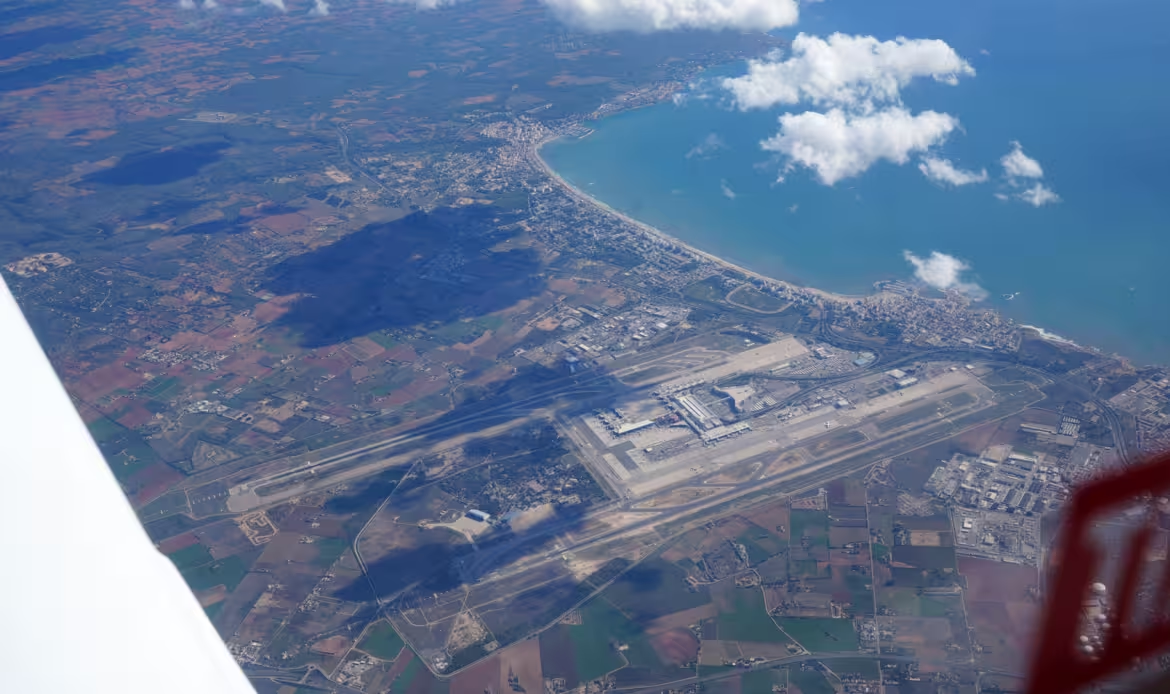
The MFD and SkyDemon showed a pretty strong North Westerly Wind across the Serra de Tramuntana, with its peaks reaching about 1500 meters to our right. We began to experience some turbulence, but it wasn’t too dreadful. I was expecting worse owing to the severity of the winds, and as we left Palma, this gradually lessened.
This would be a much shorter crossing, and some traffic outbound from Ibiza required us to take a small left turn before returning on direct NELUX, at which point Ibiza was visible. I requested descent, but it was not granted; nonetheless, after a little time, we began our descent and were vectored behind a Ryanair 737.
Surprisingly, it was bumpy, with lots of clear air turbulence over this part of the Mediterranean Sea, and while I hadn’t checked the forecast, I figured it was pretty normal for these very warm waters and the hottest time of day, even though the sun isn’t as strong as it is in the summer.
It’s worth noting that the Mediterranean at this time of year is equivalent to the Gulf, with parts of the sea reaching 30°C, so it’s not impossible to have extremely convective activity when cold air aloft passes over, but as we descended, the turbulence worsened, making for an interestingly challenging approach behind the Ryanair 737.
It may also have been the wind coming over the island, which, although not significant because I’ve never seen this degree of lumps before, made for a more fascinating approach. We had a large amount of altitude to lose, and not only did we have a rather late descent followed by earlier turns that indicated that we would be relatively fast on the approach into Ibiza until we could slow down.
As we established on the ILS, we saw the Port d’Eivissa, which included Ibiza Old Town and the La Catedral d’Eivissa from the 1200s. We also had a view of Playa Den Bossa and flew low over Ushuaïa and Hi Ibiza, formerly Space. It’s always been a dream of mine to fly into this island, ever since those late hours on the flight simulator in 2009 when I’d fly into the airport at 1 a.m. and return to the UK.
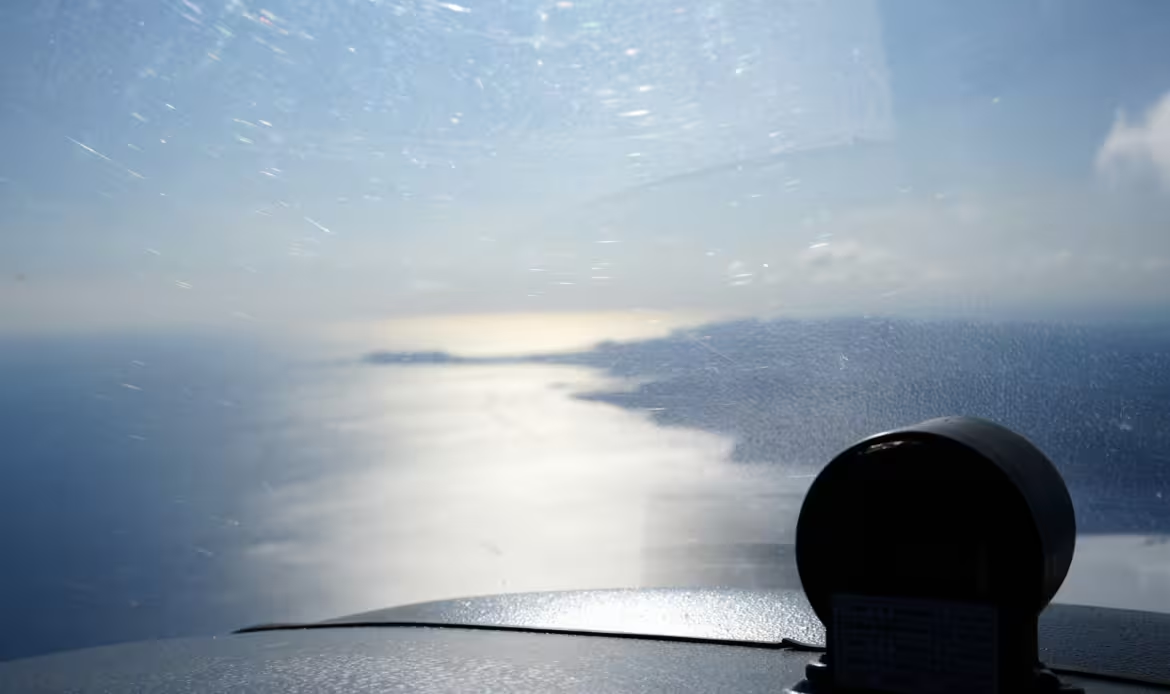
As distracting as the scenery was, it wasn’t long until we were approaching decision height on this pretty turbulent approach to Ibiza after 3 hours of flying. The north-westerly wind lessens as we begin our flare, depriving me of a memorable landing. Something that caught me off guard, but should be kept in mind when there’s a north-westerly wind blowing over the terrain, is that the airport is relatively unaffected.
We exit via E5, taxi to the GA apron, enter through G2, and follow the AENA follow me van to stand 90N. We landed at 1519z, 21 minutes before our 1540z SLOT, which probably doesn’t matter because the airport wasn’t packed; we left 15 minutes late but arrived 20 minutes early. The flying time was 35 minutes less than expected. Notable because it is a first.
When we arrived at our destination, we understood we had accomplished our goal. It dawned on me that I was really at Ibiza Airport; after many efforts, many cancellations, and much dreaming, I had successfully flown the plane here alone, which was a relief; nonetheless, what was ahead was likely the most difficult aspect.
After landing, we set the cones around the aircraft, called the refuelling operator SLCA, and were told we were in a queue. This drew the attention of the AENA workers who had marshalled us onto the stand; he was more interested in our handler, so I informed him it was Iberia, and they would take us to the commercial terminal once I called them.
When the AENA person returned, I politely asked him if he could chase the refueller. He honoured the request but then advised me to get a proper handler next time because Iberia isn’t very good. I immediately responded, “Well, that’s interesting you say that, but I haven’t even told them I’ve arrived yet.” Anyway, I understood what he was saying, but he was likely being honest while also wanting me off the ramp.
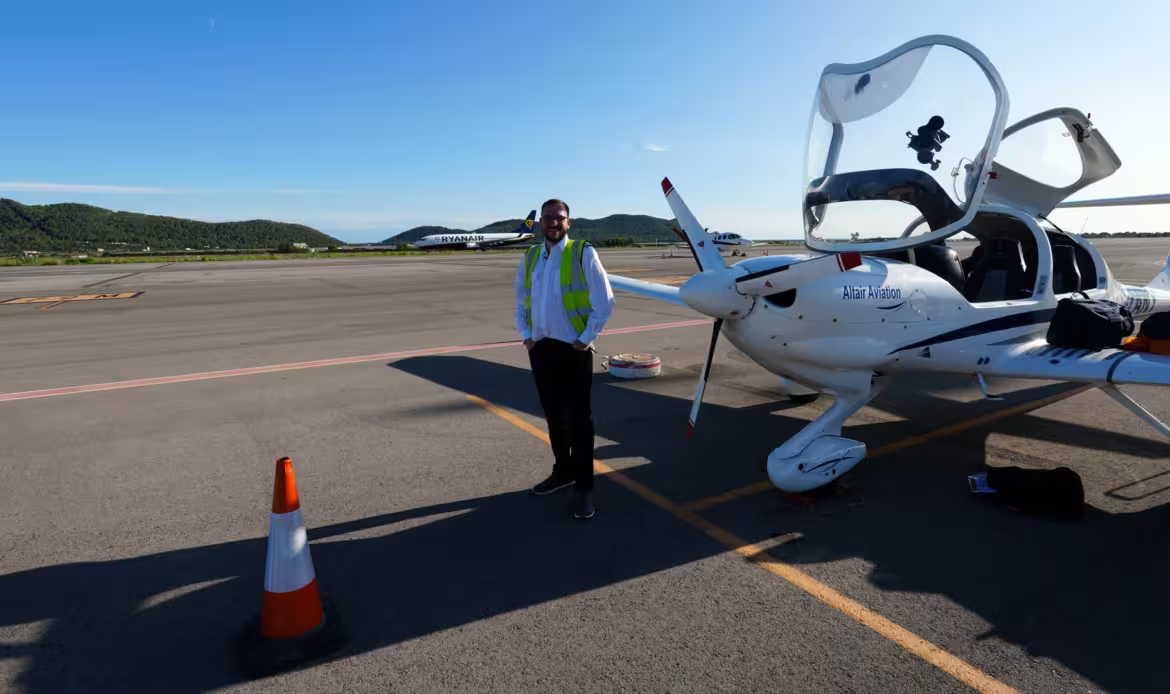
I have to supervise refuelling, therefore paying hundreds of pounds for someone to do it for me would surely be against protocol. The ramp was hot, it was peak heating, and there was this one Jet A1 bowser moving around the GA ramp, but I wasn’t too concerned. Within an hour of landing, the Jet Fuel bowser emerged, he accepted my Air BP card, and after some glances at the size of the aeroplane, queried is it was Jet A1 or Avgas.
He knew I was serious when I said we were raising JetA1, and after 5 minutes, he had split a significant bit all over the place, perhaps not knowing that putting pressure into a very small tank was a bad idea.
The worried refueller eventually resolved the issue with JetA1 on the tarmac, which is a costly mistake in a Spanish airport because JetA1 can damage the tarmac. At this time, I called Iberia, who knew nothing about me. After waiting 10-15 minutes, I called again, and they discovered my information; however, things became frustrating when they had to speak with the airport.
At this point, I was beginning to worry about how we would leave, let alone return to the plane to get the aircraft, but within 1 hour and 30 minutes, the shiny white van with Iberia on the side picked us up and transported us to the main terminal. We parked near the baggage reclaim area and entered through a pair of doors into the main arrivals area, which was probably why the person at Iberia had to contact the airport.
The person, whose English was not great, handed us a piece of paper and stated, “This was for the return,” which was a document we would show to staff security and phone Iberia to be collected. It all seemed quite simple, except for the long wait on the tarmac; something with little children or a family is probably not practical, but if you want to do it right, this is the way to go without breaking the bank.
We stroll through the arrivals like regular passengers, and there is a sea of people greeting holidaymakers or private transport providers to resorts across the island. A sense of nostalgia that you won’t get from a private GA terminal; Spanish airports appear to be ideal for this – entry at the commercial aviation terminal and a warm welcome.
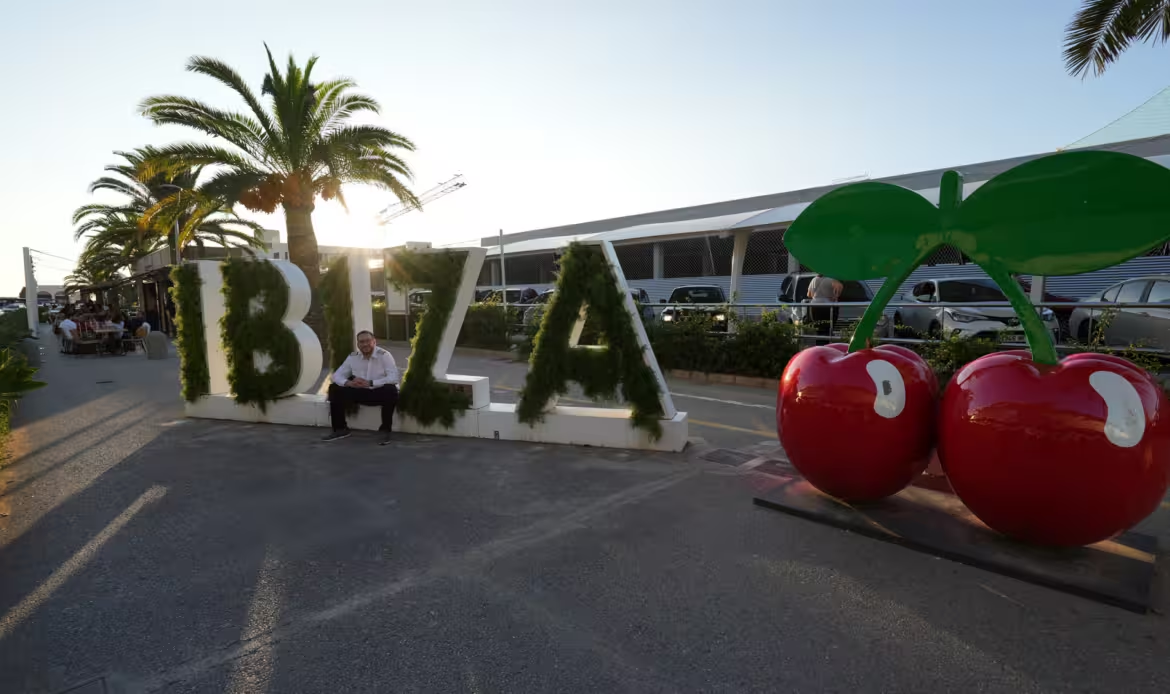
ATC Flight plan and route flown –
N0130F100 PPG A27 BGR/N0125F130 A27 POS/N0128F130
Filed ATC flight plan for LFMT-LEIB
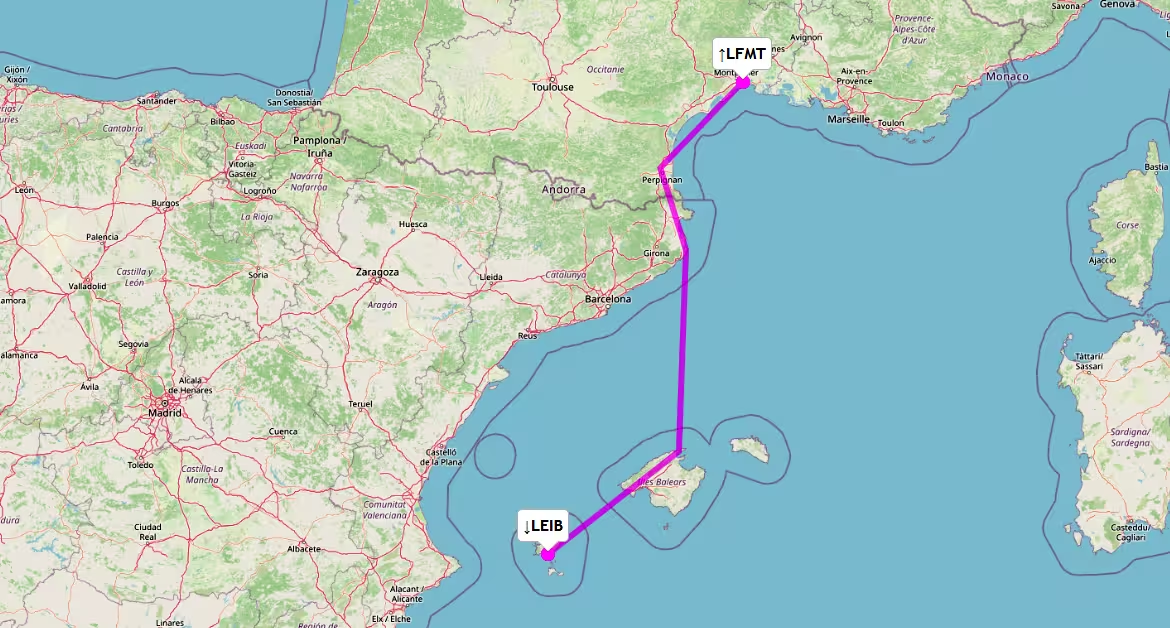
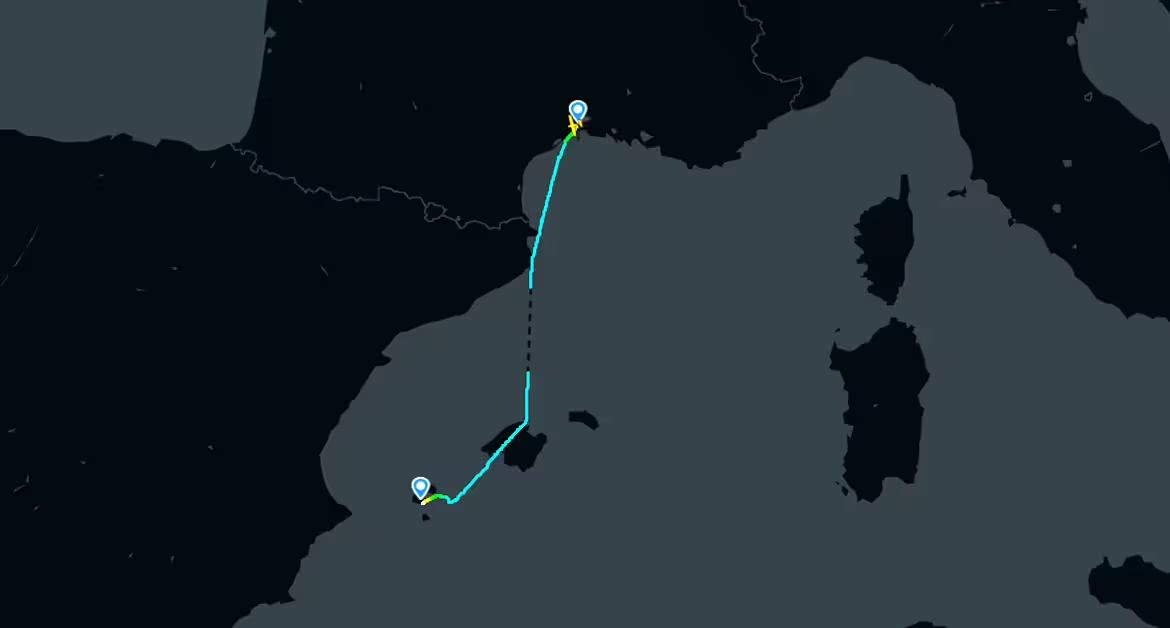
Stay in Ibiza –
When we left the airport terminal, we found the taxi rank, as well as the Ibiza sign with the Pacha Cherries, which we photographed several times. But there was one vital task to complete, and this hard job necessitated a drink. There was a row of shipping containers offering drinks, and we chose one that suited us. While I still can’t find it on Google, it existed in September 2023, so either it was removed in the most recent update or it’s something new or temporary.
Some buses serve the airport from the same location as the taxi rank; however, the service is not as consistent as a London bus. They are probably every 30-60 minutes, and I’m not sure how reliable the service is or if you’ll be able to ride comfortably.
Anyway, we proceeded to the fairly empty taxi rank and travelled to the other side of the island to our hotel, Vibra S’Estanyol, which is a 30-minute walk from Port de Sant Antoni. We arrived, checked into our rooms, and learnt that our meals would be served at the Hotel Vibra San Remo, which is part of the same network. It’s a strange setup, but it works.
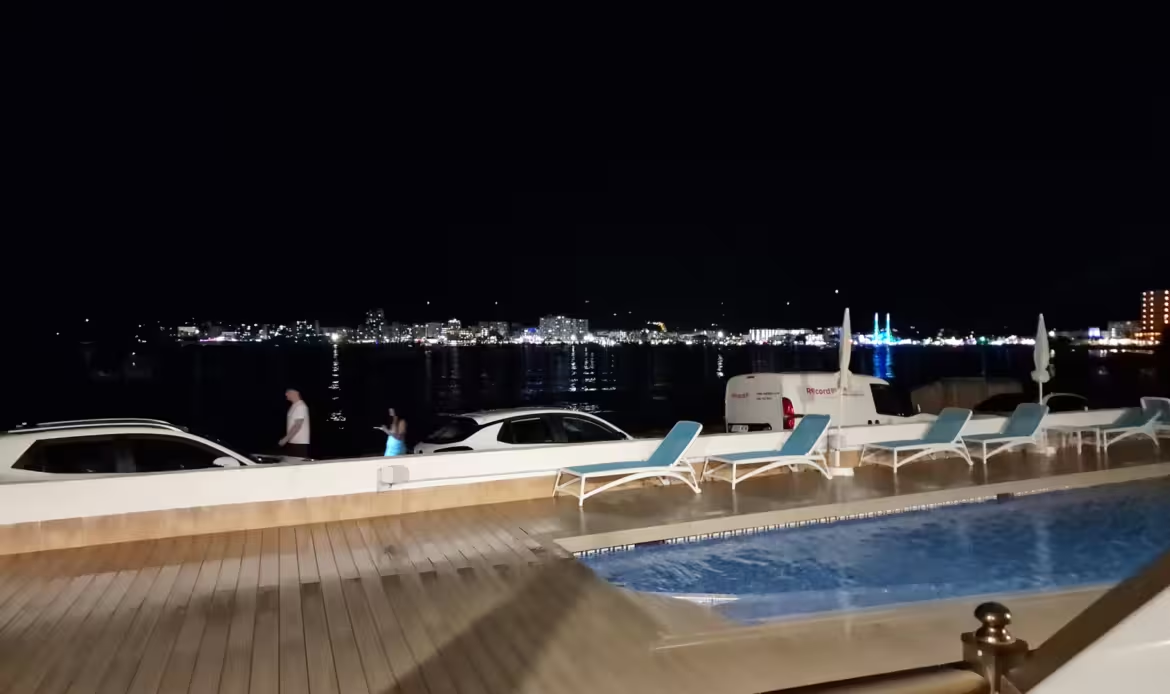
We just about managed to catch a bite to eat before the restaurant closed, as well as some beverages at the all-inclusive bar. Breakfast was served between 0800 and 1100, lunch from 1330 to 1500, and dinner between 1930 and 2130. We wanted to meet the rest of our pals at this point, so we walked to Flaherty’s Irish Bar, where we stayed until 1 a.m. Surprisingly, we ended up going to Eden next door for Defected in the House.
This was unavoidable, but it meant spending over 24 hours awake, which was not my idea of a good time – but hey, we had to celebrate making it to Ibiza. The following day would be mostly spent relaxing before returning to the clubs.
Eden has been open since 1999 and has hosted some of the world’s top DJs, including Pete Tong, Judge Jules, Disclosure, and many more. It is ideally located in downtown San Antoni, close to many of the clubs and hotels. Strangely, I had no idea this spot existed because I had only been to Ushuaia or Amnesia during my week-long vacation in 2015. Last year, when I was on vacation here, I simply went to Hi Ibiza.
Yesterday was an exhausting day, so today was spent relaxing and eating and drinking properly after a relatively lengthy time of dehydration during the long travel to Ibiza. We were able to eat and drink as much as we wanted because it was all included.
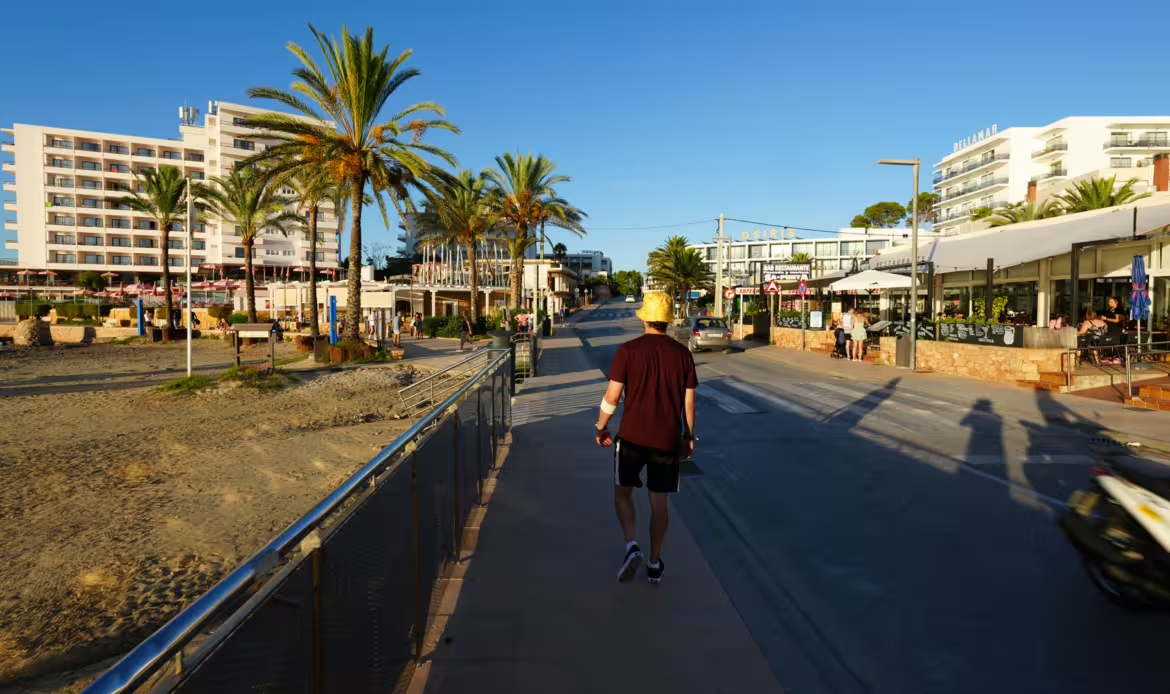
I also began uploading content to my portable hard drive so that I could capture the entire trip and set up a station in the hotel room to download all of the footage from my cameras and audio recorder. The maids must have raised an eyebrow or two when they came to clean the room, but this is currently the most cost-effective way to document long journeys. For longer recordings, I need larger memory cards, which one of my cameras does not support (wing view).
We missed breakfast, so we had a snack by the pool, followed by a late lunch because we were going to miss dinner owing to the setting sun. Tonight’s goal was to walk to Cafe Mambo, watch the sunset, and possibly see Elrow in Amnesia. I brought my Sony A7 with me to make sure we didn’t miss out on the beauty that Cafe Mambo has to offer.
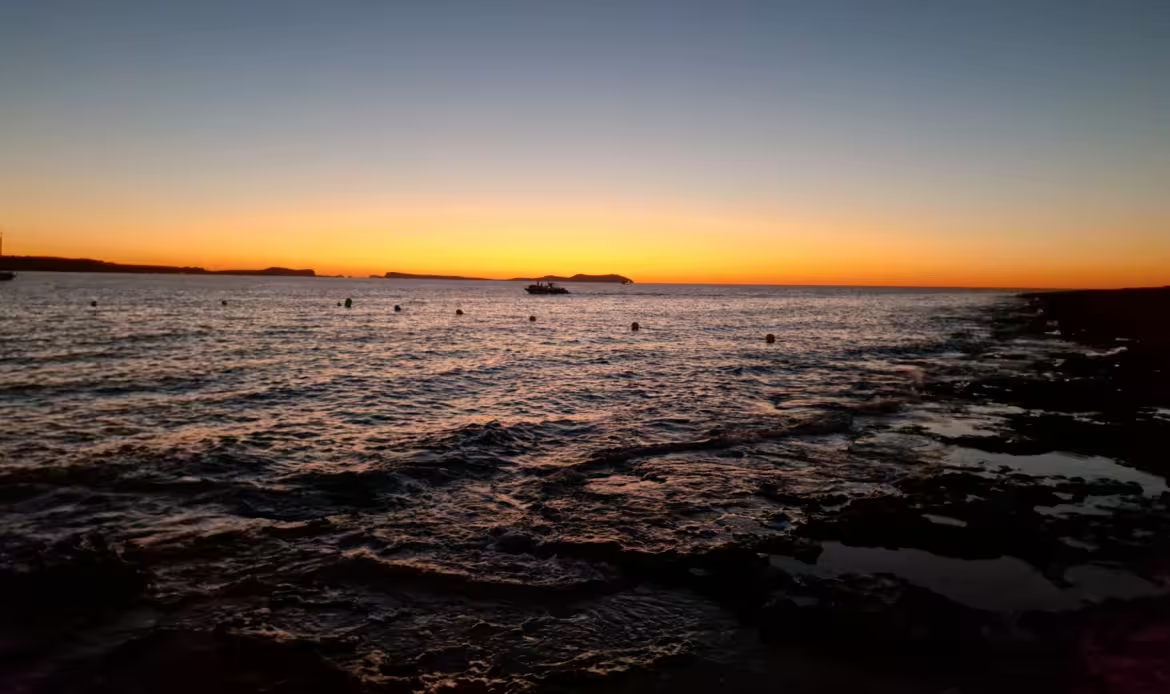
As the sun began to set, we strolled around to meet the rest of the team and listen to Cafe Mambo’s music while enjoying the sunset. We brought beers from the nearby off-license/market/Spar and drank them on the rocks and terrace immediately below the bar area.
This is highly recommended, even if you don’t listen to the music that they play at Cafe Del Mar/Cafe Mambo, because it’s the best place to observe the iconic Ibiza Sunset. This was the first time I had seen the sunset here, and I was amazed at how I had never seen it before, which was most likely because I was sleeping.
We walked back to our hotel, which took over an hour, but that wasn’t a problem because everyone was going to freshen up and we were going to do the same, as well as get in some last-minute all-inclusive before heading back to meet everyone. My step count for this vacation was going to be huge.
We met everyone at the massive Santander in town before walking to Amnesia, which I had seen twice over 8 years ago. The travel takes approximately 30-40 minutes from the harbour and is not far from Ibiza Old Town. While the Party Bus was available, we most likely missed it and chose to take a taxi instead.
It was another late night, and we stayed until the early hours of the morning before catching a cab back to the hotel, which took half an hour. Unfortunately, we would have to get up before midday to meet everyone for the bus to Ibiza Town before Armin.
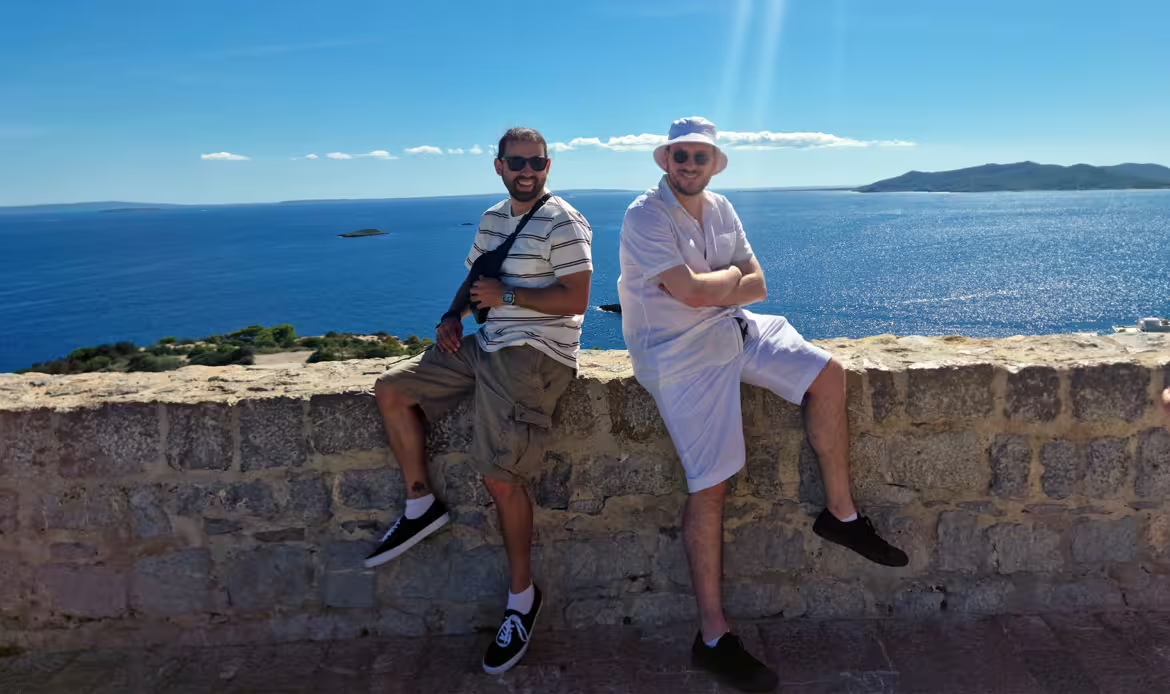
I wanted to bring my camera, but I doubted that Ushuaia would allow a professional camera within their realm, so I didn’t bother. But I’ll long to return to get a film of one of the island’s most stunning locations.
The harbour where I initially arrived last year is home to some of the world’s most costly yachts; I’m sure Roman Abramovich and Bill Gates have had a boat parked here in the past. The area boasts some of the island’s most upscale bars, restaurants, and nightclubs. Even if clubbing isn’t your thing, the historical backdrop will win you over.
We found a location for lunch and had a much-needed meal to soothe our stomachs before seeing Armin Van Buuren. We next walked up to Ibiza Catedral, which offers stunning views of Playa D’en Bossa, the Marina, and, in the distance, Ibiza Airport. This is a site I would want to return to, and I could spend hours up here. If you do, I urge sun protection because the intense rays of the sun and the heat can make you uncomfortable soon. It’s a rather steep and long climb up, so bring some water to stay hydrated.
We walked to the bus station but discovered that there were no buses available to take us to town. So we decided to take a taxi or two and share the ride to Ushuaia. It was a long walk, and we had a busy evening ahead of us, so we opted for transportation.
We arrived rather early, so I brought everyone to Mumak, a restaurant/bar facing the shore a short walk from Ushuaia. This is a decent restaurant with a large menu and a fantastic curry that we enjoyed last year. It is a great place to eat.
It’s also worth noting that Dunes, located up the street, has a lot of nice food to offer in the neighbourhood, and if you’re interested in aviation, it’s a great place to spot planes because an aeroplane roars overhead from the local airport now and again. A paradise for me.
Along this road, you’ll be approached by one or two men who want you to buy illegal items from them, and the only thing you can do is politely say no thank you to divert their attention, and as with anywhere on the island, keep your belongings safe and out of sight, especially in hotspots like this.
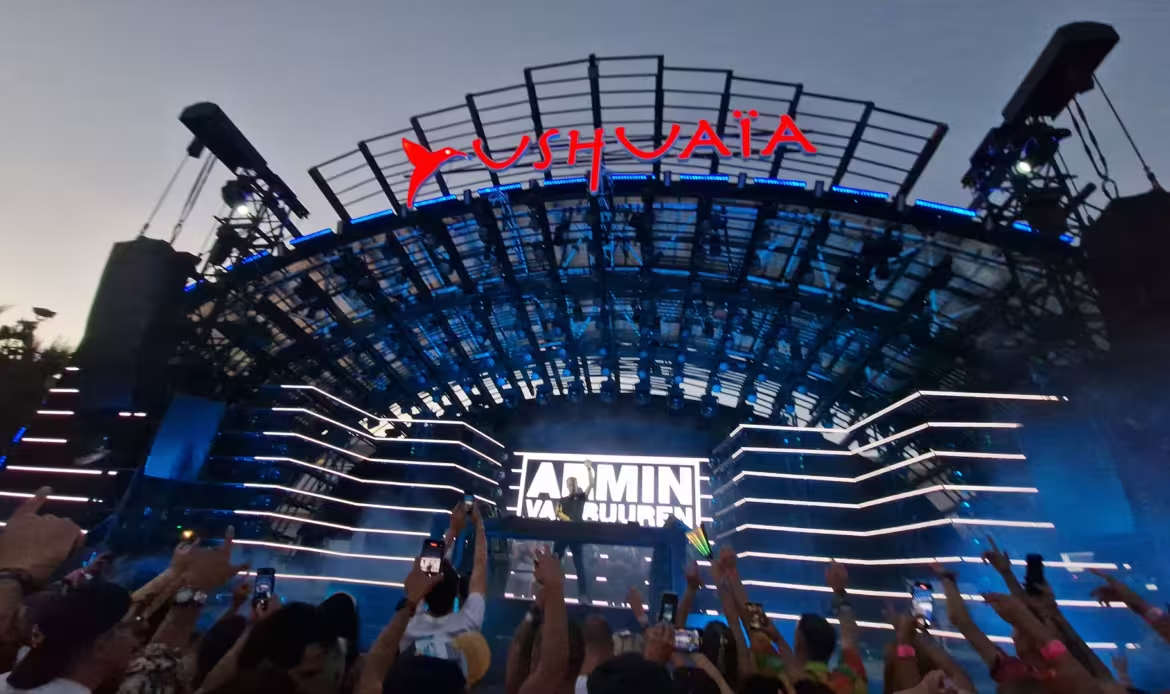
This is a common occurrence in most tourist destinations in Spain, particularly in Barcelona and Ibiza, where alcohol is widely used. So, like in any other tourist-heavy location, you must keep your wits about you.
The highlight of this trip was witnessing Armin at Ushuaia perform an extended set. Avira was on first, but we chose to skip the first half of his set in favour of lounging on the beach. Armin Van Buuren has been ranked as the number one DJ by DJ Mag five times, four years in a row, and is still a regular on these islands, although diminishing the number of shows he attends over time.
When I came in 2015, Armin had a weekly residence from May to September. After the Pandemic this changed to the last few weeks of August and September, and it is now only September for four weekends, rather than weekdays throughout, due to spending more time with family.
The event was exactly as I remember it: aircraft flying overhead, a setting sun surrounding a pool in the island’s best hotel and a world-renowned outdoor nightclub. The location is quite close to the airport and Ibiza Town. Many of the world’s most famous and prominent DJs have performed here, as have other well-known entertainers such as Kylie Minogue.
The sun would set earlier at this event than at the one I attended in August, but it was considerably more vibrant than Armin’s Hi Ibiza residency last year, which was held in the former Space nightclub across the street. I’d seen Armin several times previously, but this was the first time I’d flown to see him after numerous efforts. This was also one of the rare times I’d been able to get backstage and take a selfie with the guy himself.
We shared a taxi with several of the others back to our hotel; this was the first night on the island that I got to bed at a reasonable hour, which was much needed, as we had missed supper at the hotel and planned to eat at a local kebab restaurant, of which there are many in Ibiza.
We’d have a fairly relaxed one and catch up on some much-needed sleep. After lunch, we went to the sister hotel in San Antoni to meet some of the crew members before walking to Cala Gració. This beach, with its magnificent blue waters, is a short walk from the main areas, and we again purchased some wine from the local shop to have a great evening of refreshments and munchies. Something unique for a change.
The sun was about to go down, and we wanted to freshen up for a relaxing evening at Flaherty’s Irish bar, but first, we’d take the ferry from the main port to just outside our hotel. This saves you time by avoiding the 30-minute stroll along the bay, however I still prefer walking.
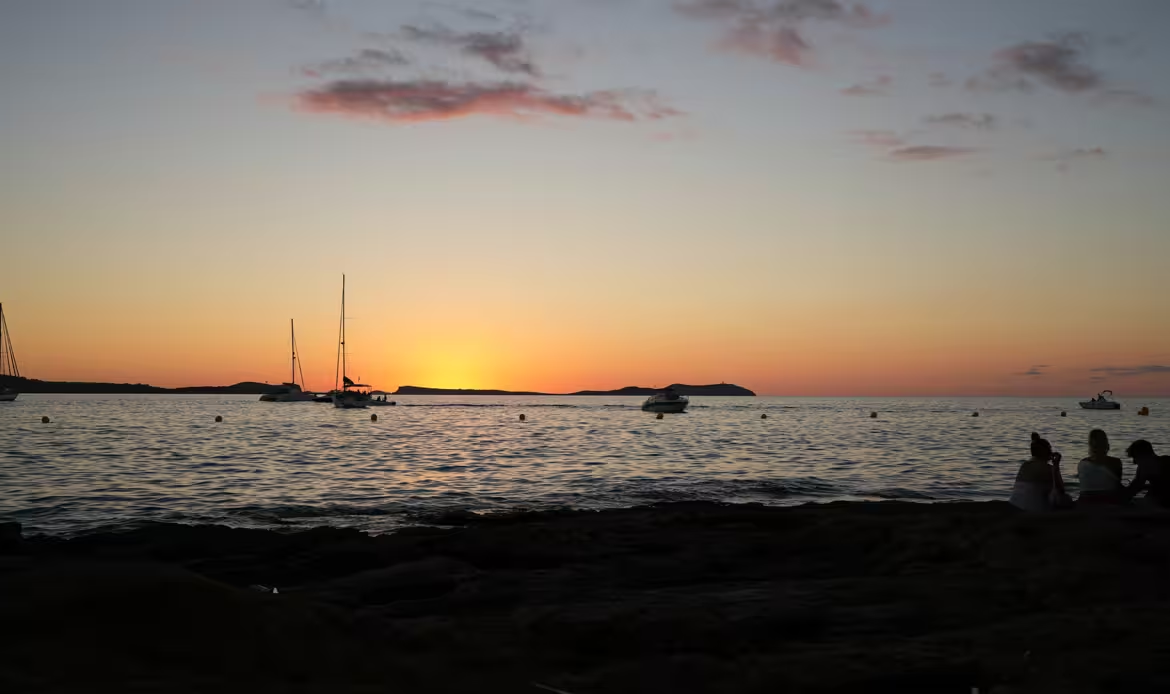
This also allowed us to quickly grab some food and drinks before the restaurant closed and stroll back into San Antonio. There were no plans to go out, except for a few beers back at Flaherty’s, which is an excellent place for socialising and starting a night out.
Next door in Eden was Chase & Status, and the temptation was just too much, even though the next day was a huge night, which caused us to extend our trip from 5 to 6 nights. So we gave in to peer pressure and stayed in Eden till 6 a.m., and we had no regrets, which is a rule in Ibiza. Of course, this isn’t everyone’s idea of a vacation, but what happens in Ibiza stays here, right? I’m sure we had a kebab on the way back since we saw someplace still open.
The following day, we considered returning to Café Mambo to enjoy one last sunset before our final night in Ibiza. The final night had to be relaxing because I would be flying back to Stapleford via Montpellier.
We awoke at lunchtime and decided to go to the restaurant for some much-needed dinner before spending the first and only time of our trip sitting on the beach. Of course, this trip could have been more leisurely, with fewer evenings out, and in retrospect, it would have been more of a vacation, but this was Ibiza, and we were doing it in style.
The next stop was a visit to Café Mambo for some more beers on the rocks to commemorate our final night out, and we went about and met up with the majority of the team before settling down for the evening. We’d make a sprint back to the hotel to prepare for our final night out, and thankfully, the restaurant was still open, allowing us to eat before driving to the bus station for the party bus to Amnesia. This takes about the same amount of time as a taxi but costs a tenth of the price. It is less convenient, but we had seats on the bus and avoided the latter crazy rush.

Amnesia presents a commemorative trance night for Kevin and Perry Go Large. The movie is a 2000 British teen coming-of-age sex comedy film based on the Harry Enfield skit Kevin the Teenager, in which Amnesia appears. The film was the highest-grossing film in the UK.
It was around 5 a.m. when we decided to return to the hotel for a somewhat relaxed day by the pool, lunch, and some final cocktails before going out to dinner later that evening. This would give me time to finalise my plans and prepare for tomorrow’s long day, which would not be easy by any means.
Pete recommended Urban Lounge, which was a short walk from our hotel and served delicious cuisine and affordable drinks. We mostly got Chicken Fajitas because we were tired of the all-inclusive selections by this point. This was a pleasant evening to round off nearly a week in Ibiza, flown in by a light aircraft, and the achievement and ambition had finally been realised after many years of effort.
Weather Forecast (Return) –
The general forecast for Ibiza and Montpellier was for settled weather with a high pressure centred over the Pyrenees, which meant that early morning mist or low cloud would clear as we drove to the airport, and a weakening cold front would stretch across mainland France with little wind until we reached the UK.
When we awoke, the TAFS predicted decent weather for our journey, including the UK, despite a complex frontal system approaching after our arrival, but we might meet some rain depending on how fast the fronts moved.
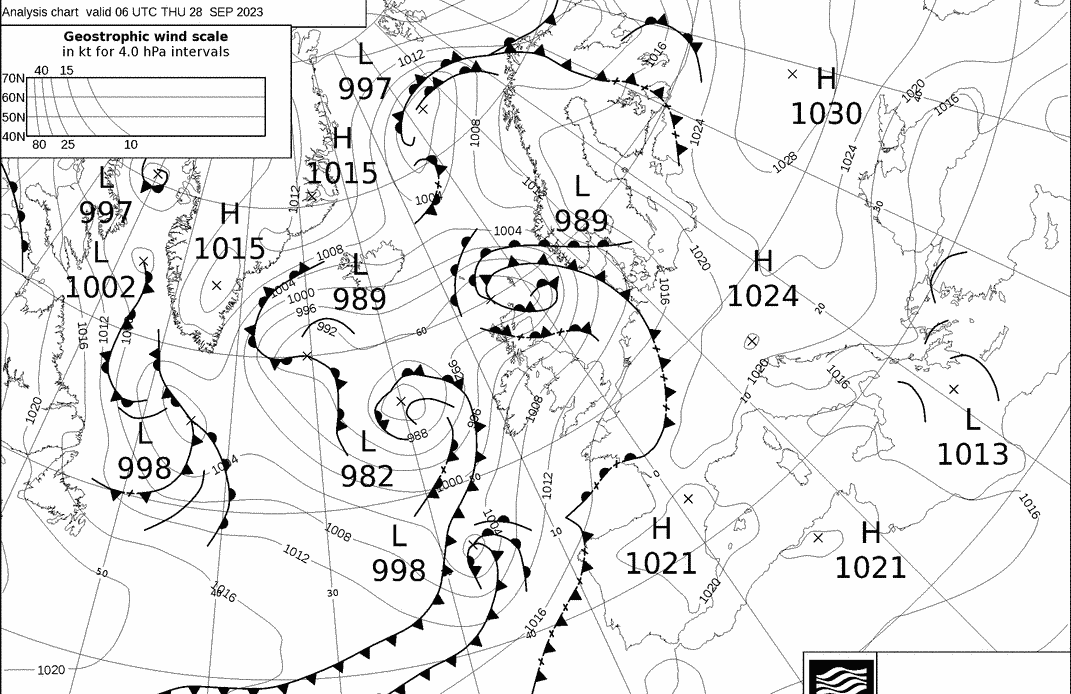
TAF LEIB 280800Z 2809/2909 18005KT 9999 FEW020 TX26/2812Z TN16/2905Z=
TAF for Ibiza, Montpellier & London on 28th of September
TAF AMD LFMT 280638Z 2806/2903 04003KT CAVOK TEMPO 2806/2808 3000 BR OVC010 PROB40 TEMPO 2806/2807 0300 FG VV/// BECMG 2809/2811 17010KT BECMG 2819/2821 VRB03KT TEMPO 2823/2903 1500 BR BKN003=
TAF EGSS 280454Z 2806/2912 23010KT 9999 BKN027 BECMG 2815/2818 17012KT TEMPO 2820/2907 6000 RA BKN012 PROB30 TEMPO 2821/2902 18015G25KT 4000 +RA RADZ BKN008 BECMG 2900/2903 24012KT BECMG 2904/2907 30012KT=
The prediction FAX was for just after our arrival, but it would be reflective of the weather expected in London. A weakening warm front, followed by a cold front and more frontal systems. A pretty complex system with many fronts approaching the UK, but nothing notable in the TAF. If we were delayed or had a technical difficulty that necessitated a quick stay in France, we could still land at Oxford or Southend, or at best Biggin Hill.
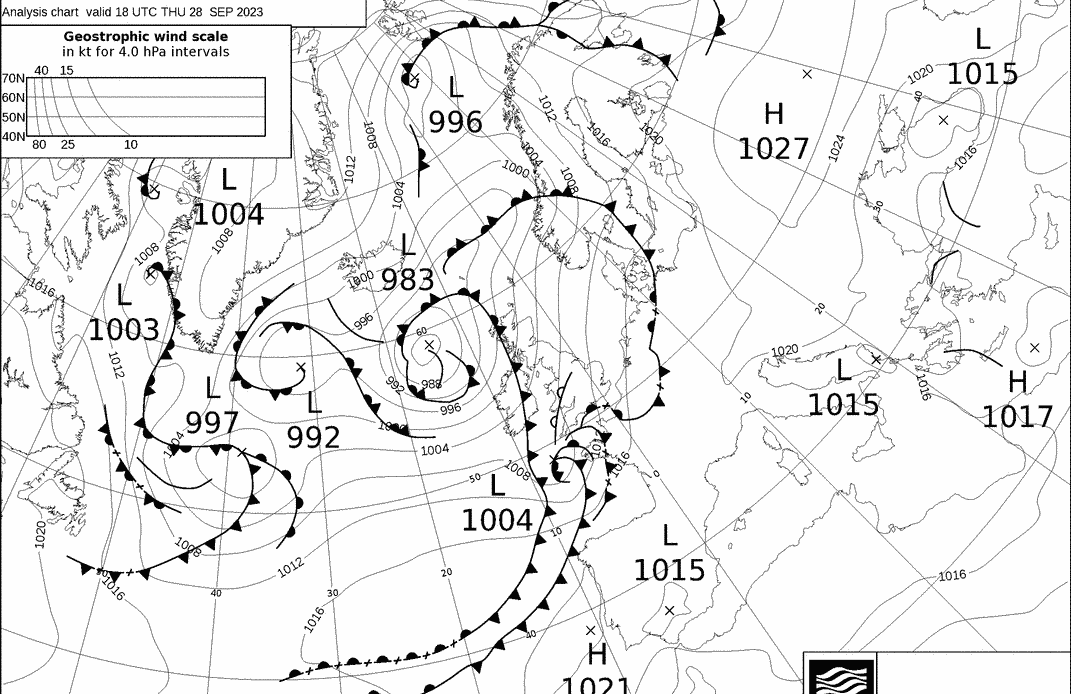
It appeared that the trip had concluded at the appropriate time, with frontal weather setting in the coming days – but nothing that we couldn’t handle in the aircraft. The risk with September is that you can sometimes get ex-Hurricanes, as we discovered before and during our trip to Spain, highlighting how the weather can change very quickly, even within a week, as significant weather can deviate fairly quickly and have an impact on our weather over here.
It’s a good idea to have and plan for options, especially in light general aviation where some weather cannot be outclimbed and major cold fronts can endanger the flight’s safety; on the other hand, warm fronts can be expansive with few or no options for getting out owing to freezing rain.
Payment of AENA Fees –
You can now pay your AENA fees at the Airport POS instead of walking to the AENA office. Any further charges imposed by a local handler (where applicable) should be paid directly to the handler.
On the morning of your departure, respond to the email you received with your budget and request an invoice, specifying your arrival time as well as your expected departure time and date. They will usually check which handler you utilised. It is prudent to submit as much information as possible; you may then pay your invoice using the following link.
Ibiza VLOG Part 2 –
Flight to Montpellier –
It was an early start to the morning, with a wake-up call just after 7 a.m. for the 1030 local departure block back to France for the long journey to the UK. I wasn’t sure how simple it would be to circumnavigate Ibiza Airport via El Cheapo, so I allowed myself plenty of time to go to the airport, eat breakfast, and relax before walking out to the plane.
We took a taxi to the airport and arrived in 40 minutes. We initially needed to locate the staff security checkpoint, as this is where we would be picked up by the handler and transported to the plane. We got a little lost, but we found some breakfast before heading to the plane and checking it out for the long day ahead. Probably the most expensive Panini ever, and one without coffee, which disappoints me, but coffee with flying without toilets is never a good idea.
We used the facilities for the last time before heading to France and ultimately found the security entrance. We phone Iberia and proceed to the security checkpoint, where we are searched in preparation for our eventual pickup by Iberia. When Iberia arrives, things move fast, and we are driven out to the plane within 15 minutes.
It was a warm, moist September morning, the wings were completely coated in morning dew, and the first flights of the day were departing from Europe. We had about 50 minutes at the aircraft before departing, however once checks were completed, the aircraft loaded, and the cameras were reinstalled and fitted, it was time to contact ATC for clearance.
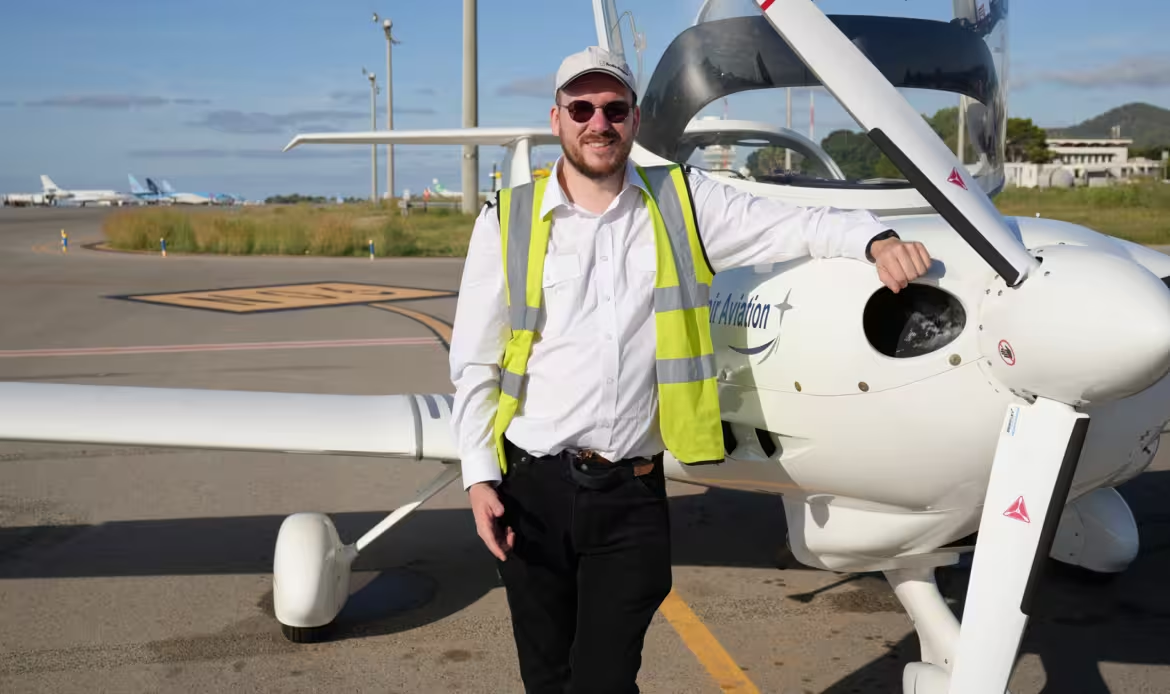
Only then will we be able to proclaim this entire effort a success, since Ibiza has completed El Cheapo. We cleared Le Conos, which was stored in the aeroplane and moved by hand (forbidden), so we had to go quickly onto the taxiway behind us.
There is no other means (save what they had at TAG Bologna) to get the aeroplane to reverse and taxi ready. The only other option is to use the stand’s own power, but there isn’t much distance between us and the others. A road opposite us, and on the other side of the plane, a stand for larger planes.
We were also on stand 90N, which was rather near to the GA taxiway. With nothing approaching this section of the airport, we chose to push, and how challenging it was without the tow bar (which I’ll work on getting in working order) and brought onboard because it’s difficult without it.
We confirmed that the stand was clear, then stepped into the aeroplane and started the engines. After we had verified all items and briefed the departure, we requested ATC for a taxi to the active runway. There is a body of water just south of the airfield with a distinct mist; this is the Es Codolar de les salines.
We taxied out to the far end of the runway we had landed on over a week before, allowing a Ryanair aircraft to depart ahead of us while we finished our power checks. One aircraft was scheduled to land while we waited for wake vortex separation from the Ryanair departure. We were scheduled ahead of another arrival and began our return to the UK, swiftly becoming airborne, hoping that some of our friends would see us depart, but I believe they were in the bar.
We were handed off to Palma Radar and climbed to the flight levels, which were initially lower than our planned cruise. Surprisingly, despite the low ambient air temperature, a yellow coolant level warning light came on. This normally indicates we need to lower power while increasing airspeed, which usually results in this being resolved.
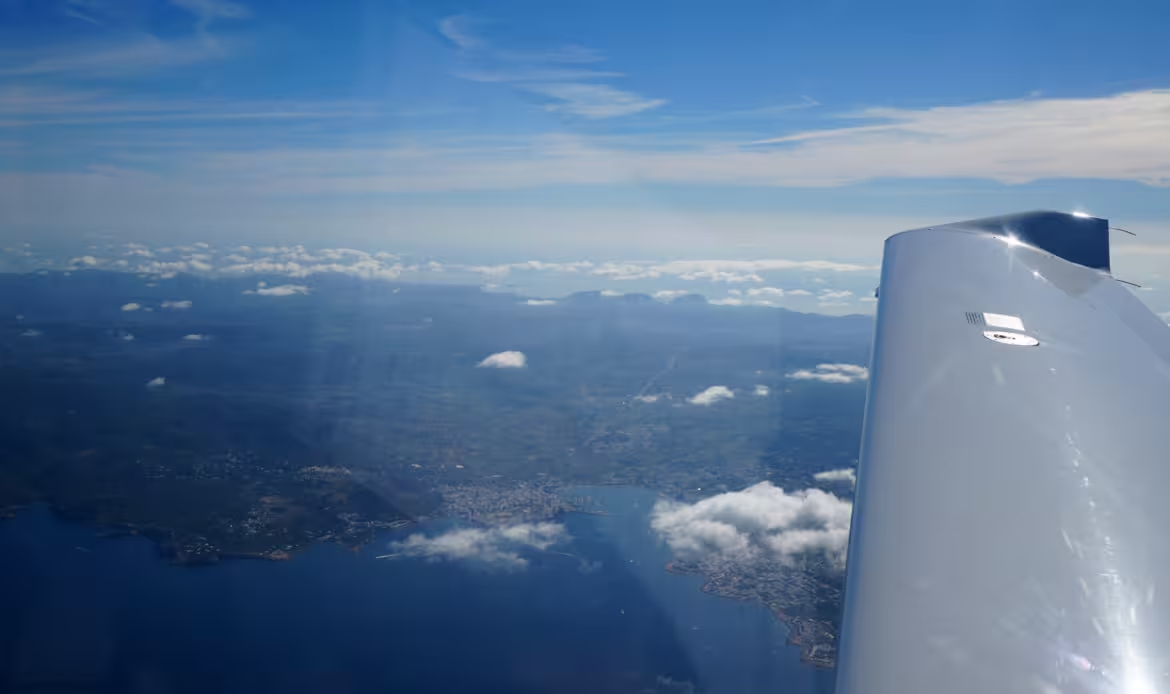
I informed ATC that we had some issues with performance and would be climbing slower. This was followed by a TUI UK departing behind us on the same route, where he climbed up and around us because of our slower climb to FL160.
We briefly entered the red zone, which raised a few alarms in my mind because there was so much water ahead of us and we were so close to deciding to return to Ibiza, but it quickly changed from red to yellow to green before returning very briefly. We slowed the climb rate once more and increased airspeed at this time to alleviate the problem, and when the OAT dropped a little more, the problem went away for the rest of the flight.
I believe this was a sensor issue because all other temperatures and pressures were in the green area, and if other problems had arisen, we would have undoubtedly diverted back to Ibiza, but this was the last thing we required.
Once we got settled on the cruise, I attempted to negotiate a shortcut because the flight plan zig-zagged across the congested airspace while avoiding any military airspace in the region. Typically, ATC will direct you through it because it is usually active but nothing is flying in the area you would be crossing. It was worth a shot, but the controller tried negotiating and was unable to grant a shortcut due to traffic.
Barcelona is a highly busy airport that has banned SEPs owing to the traffic problems they cause, but as you get closer to the airspace, you understand why. Unfortunately, they’ve decided to limit CAT A SEP, but this is typically due to air traffic control having numerous concerns, such as greatly delaying commercial aircraft.
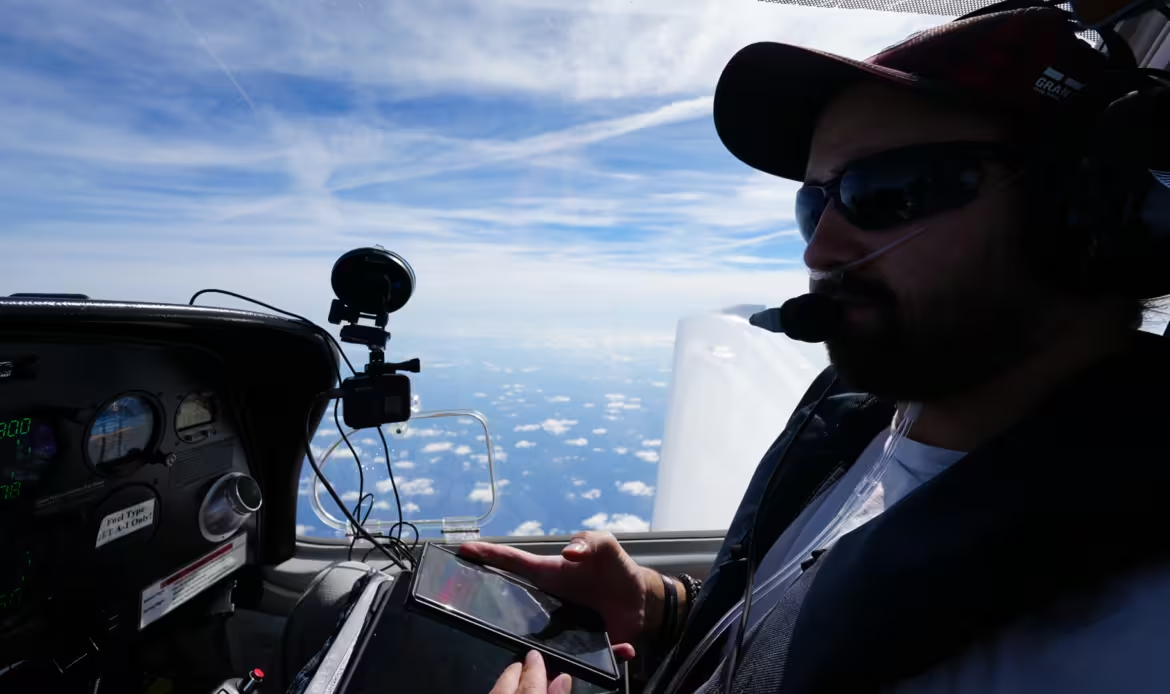
This crossing was significantly longer on Airway N856, and any shortcut would take a longer route over water but save time by covering a lesser distance to Montpellier. We switched frequency to another controller, and they informed us that they were already attempting to negotiate a shortcut.
A short time later, we were given the direct KANIG, which is part of the entry into Girona and a waypoint on the French/Spanish border that appears to be busy with IFR travel between the two countries. We were rewarded with an incredible perspective of Barcelona, which I had only seen twice in my life and would gladly return to in the future. It was fascinating to witness the progress of the Nou Camp, which is undergoing extensive expansion and renovation.
If you wish to travel and fly to Barcelona, I recommend stopping at Girona and then taking a taxi or public transportation to the city.
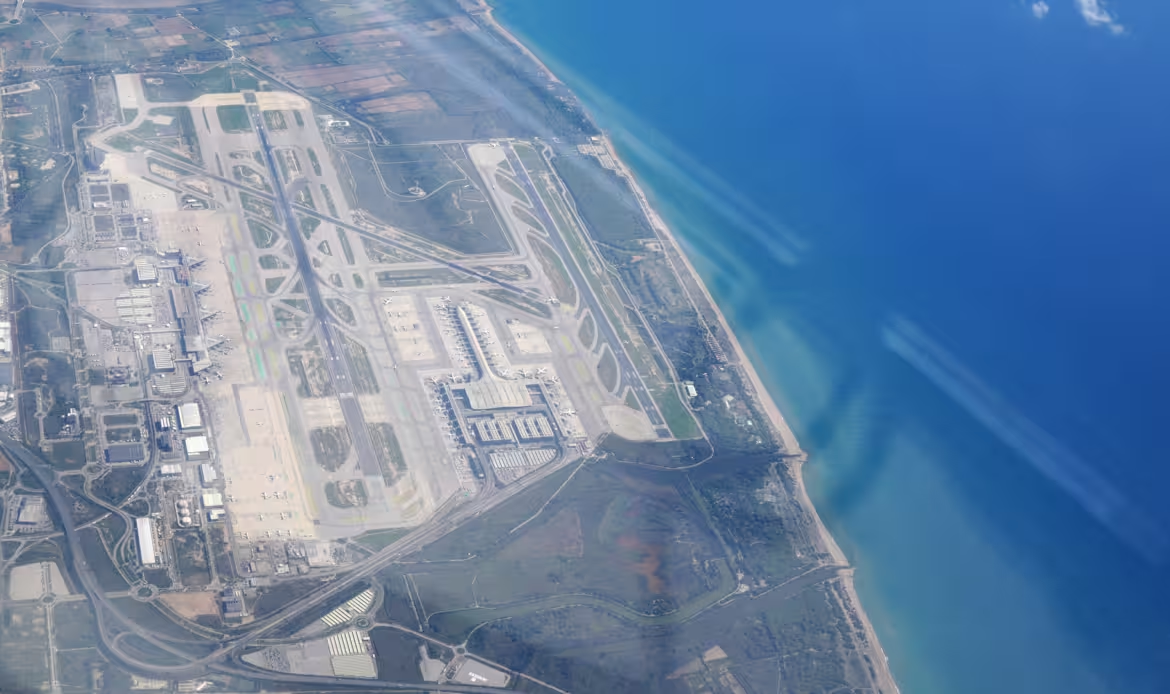
As we approached the high terrain just north of Barcelona, we began to experience turbulence and wind changes, most likely caused by the neighbouring Pyrenees. I’ve encountered problems in this area before, most notably a mountain wave with a spike in airspeed and a decrease, but this was only some little turbulence that could worsen.
Precautionarily, I requested a vector to the right in case it was the north-westerly wind blowing over the terrain, which it most likely wasn’t; it was probably thermals from the landscape below or clear air turbulence created by the terrain in a north-westerly wind.
ATC was quite helpful, and I’m sure a few on this busy frequency raised their eyebrows at my worry, but this was a 1.15-tonne aircraft, and the considerations for an airliner are significantly less than mine. The conditions eased out as we got closer to KANIG and the Pyrenees, though not near the higher peaks.
The region near KANIG appeared to be rather congested, and we were given an early descent to FL100.
This is most likely what the two local ATSUs (Marseille and Barcelona) have agreed upon, as I was unable to fly higher than FL100 on my prior journey in this area. Because of the topography, TCu and occasionally CBs frequent this area of airspace, which is why a straight crossing requires millpond conditions, nevertheless alternatives such as San Sebastian, Toulouse, or Bordeaux would necessitate more settled conditions.
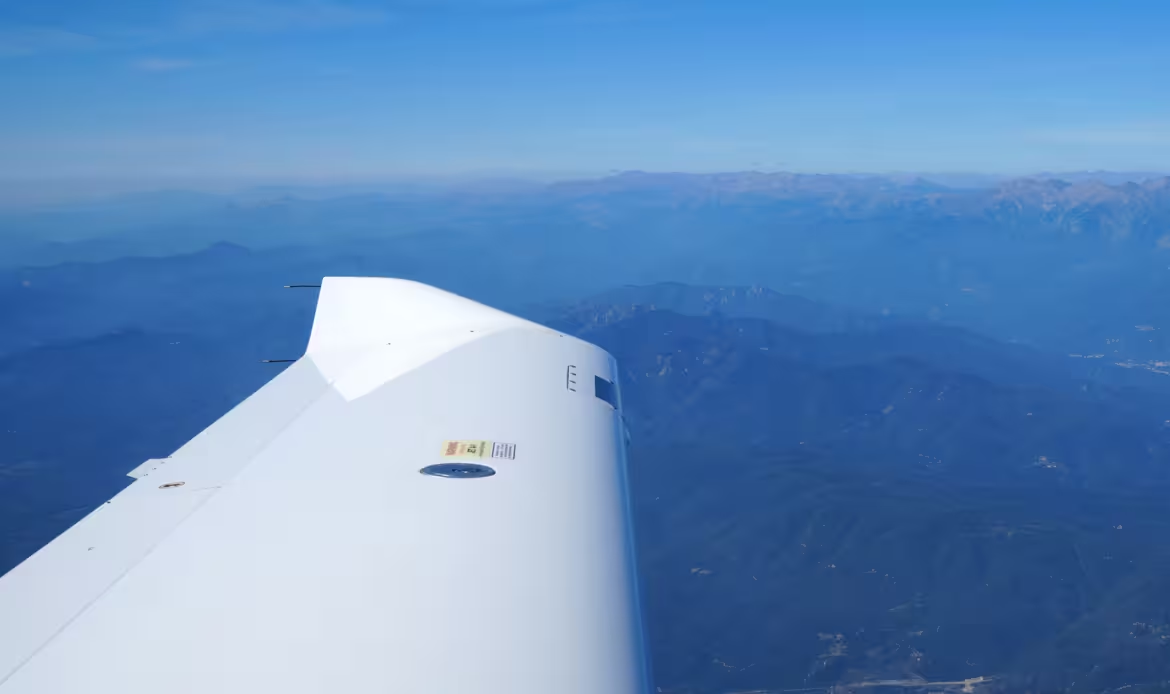
We were soon passed off to Montpellier, who provided us with an alternate route via military airspace that resulted in an unexpected routing, saving us even more minutes and resulting in a shorter flying time than scheduled.
We were given a routing to rejoin the STAR, but a big shortcut before performing the LOC DME into Runway 30R because the glide path was still unserviceable. This was a little difficult, but it was good preparation for the regular RNP or ILS procedures I use on my trips. My personal currency preference is to do ILS approaches and RNPs on each trip I take, as I only fly once a month owing to expense and time constraints.
The only intriguing aspect is that a wholly non-precision approach of this sort necessitates a higher degree of attention, which can be difficult to achieve after a somewhat long sector. Regular flying is crucial, but regularly flying varied approaches can help you develop autonomous memory, which you won’t have on a glide path out, where you’ll have to cross-reference altitudes with distance.
The NOTAM said that taxiway V was closed due to ongoing construction on the airfield, which we had noticed during our previous visit. We exited via V, then T3 and L3, and finally F parking. Our normal stand, F2, was taken, so we parked on F4, where someone else was being refuelled.
I asked the controller if he could call ahead for our refuelling and if the payment machine was now operational, as I had emailed the AD operations team previously to double-check that everything was well following the outbound hitch.
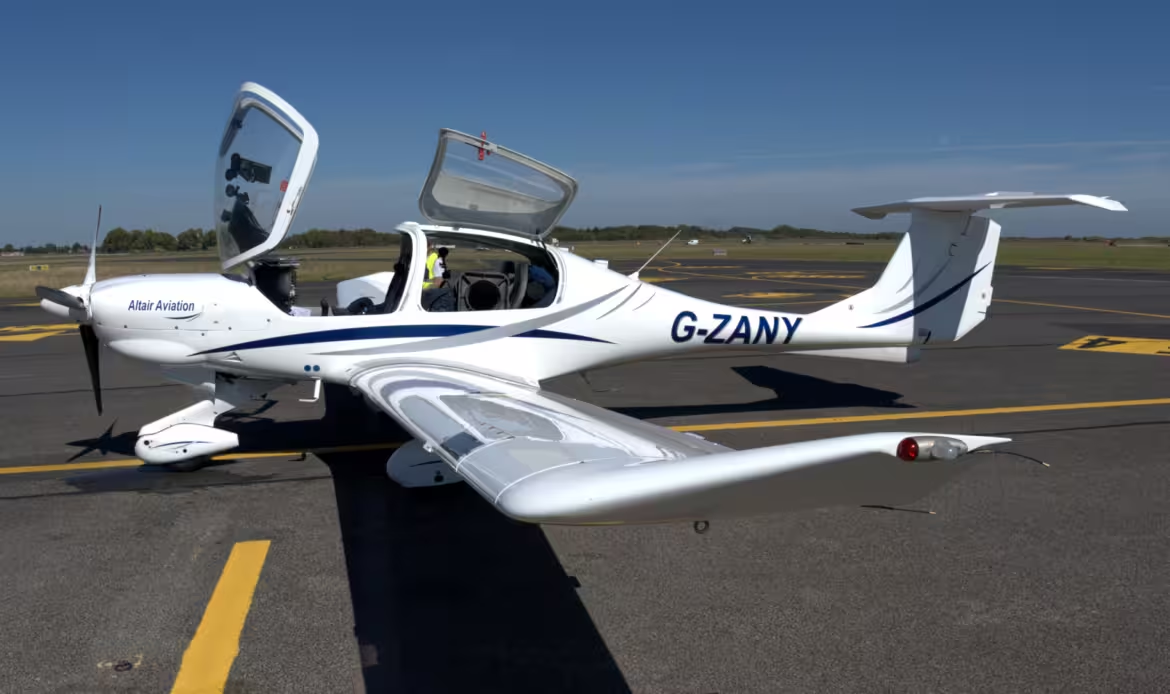
After waiting two minutes for the turbo to cool down we refuelled, paid by credit card, and headed to the GA terminal. We exited the facility and headed to the main terminal in quest of lunch, as it would be a long day to go on only a toastie.
In the main terminal, we went to Trib’s café, which had a few options, including a hotdog and a MARS bar. This was okay, but the food was probably delivered too late in the day, so the baguette was less digestible, and the mustard was a little too strong for me, but I ate it.
We had this extra time because of the shortcuts granted by Spanish and French ATC on the route into Montpellier, which allowed us to have adequate turnaround time before returning to the aircraft for the return flight. We landed at 11:18z, giving us well over an hour till our departure time back to the UK, and by 1340 local time, we had refuelled and were eating dinner. This seemed more comfortable for a turnaround than the outbound portion; it made a significant difference.
ATC Flight plan and route flown –
N0130F160 EPAMA UN856 EBROX UZ444 VNV UN861 LATRO UL110 BGR UN855 KANIG A27 BRUSC
Filed ATC flight plan for LEIB-LFMT
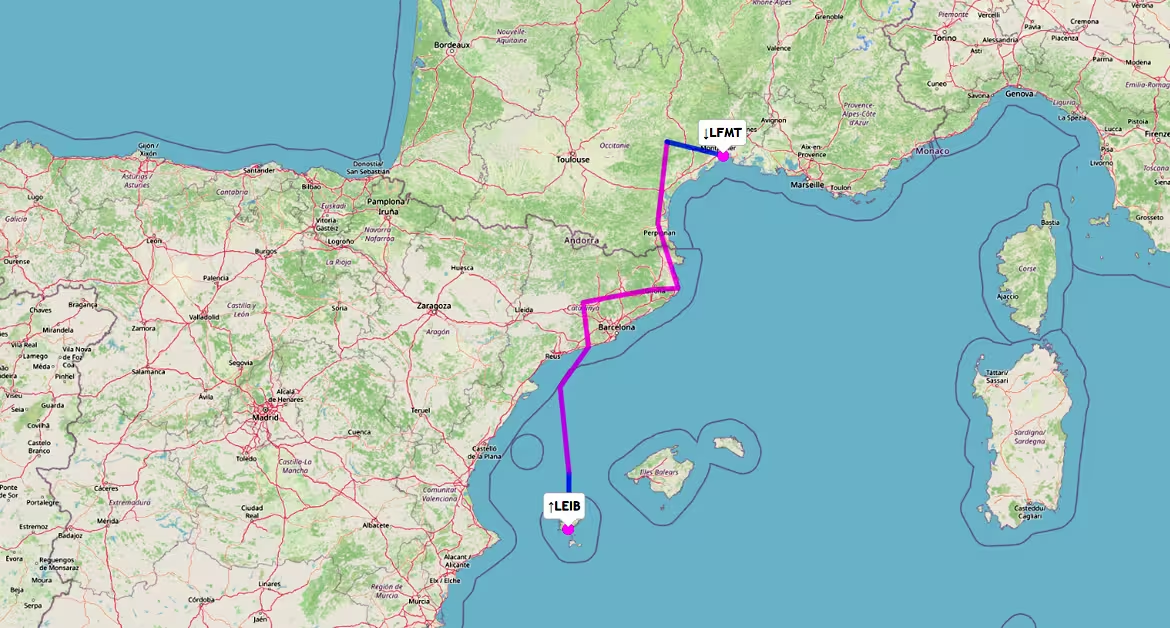
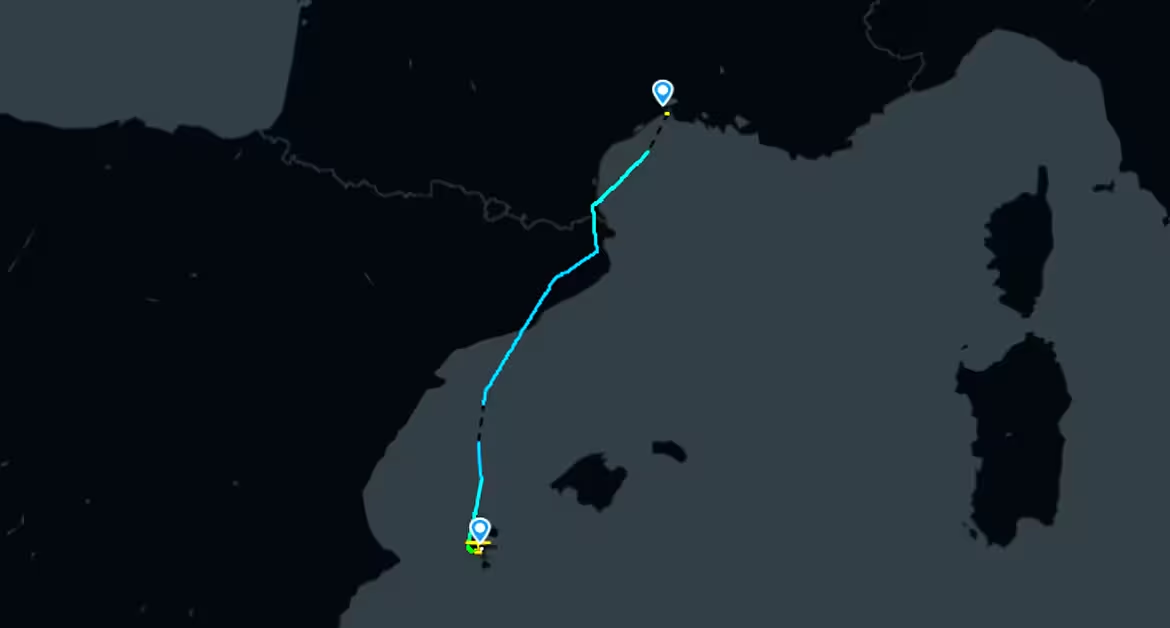
Flight to the UK –
After more than an hour on the ground, we had prepared the aircraft and the cameras for the following sector, and by 1454, we were flying for the UK, with no SLOT or weather concerns throughout the journey back to UK airspace.
There was a runway change, and it was my first time landing or departing runway 12L, so we taxied to the runway and were given holding point Y for departure on our long flight back to Stapleford. We began our final take-off roll of the trip with a left turnout shortly after departure. We were promptly handed off to approach, who originally climbed us up to FL140 before climbing us to FL160 and giving us a few shortcuts.
The conditions for this trip were significantly smoother than those in August, except for the occasional lump and bump as it approached peak heating conditions. Surprisingly, while flying at a flight level of 160, we reached a density altitude of 18000 feet. That feels extremely remarkable, and the aircraft achieves this flight level relatively rapidly, in around 35 minutes or so, depending on ATC restrictions.
I typically get a better TAS at this level of 80%, and if I need more fuel, I lower it to 70-75%; anything less seems quite slow, and I wouldn’t require this unless the destination weather was less than perfect and tailwinds were strong.
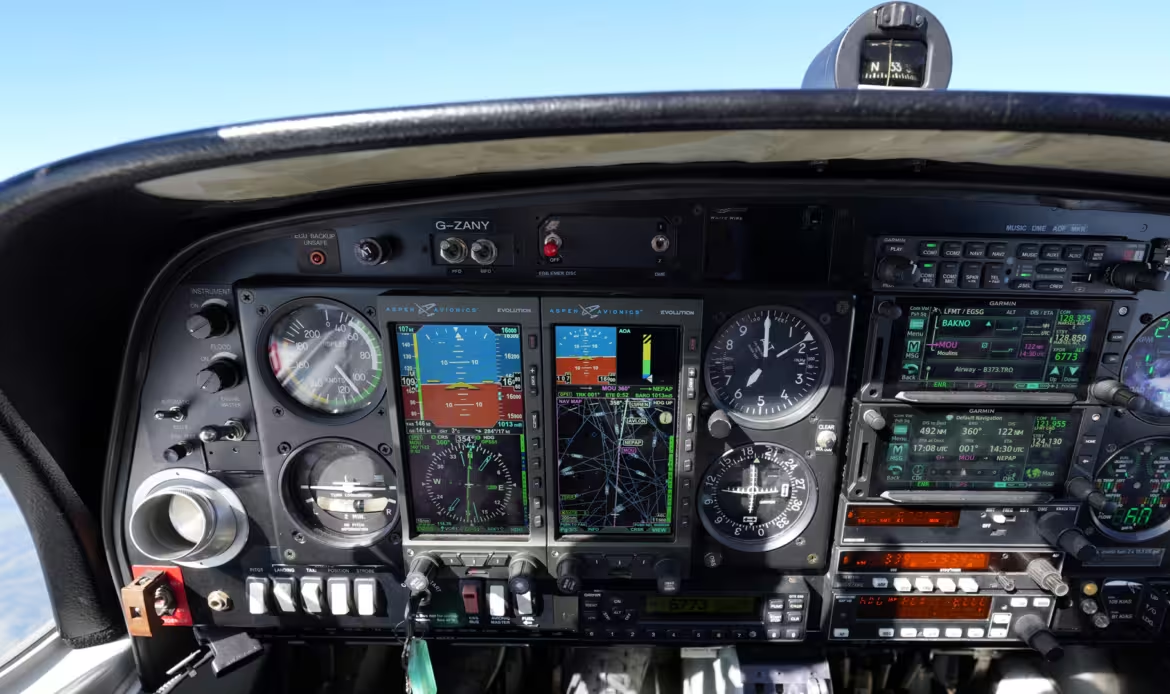
The OAT was very warm, and we experienced the occasional lump and bump as we approached Paris, most likely due to clear air turbulence, which was unusual given how flawless the flight had been thus far. This turbulence was notable for its duration rather than its intensity.
Paris ATC was extremely active in its eastern section, with many arrivals from Europe, the Far East, and Asia. It was quite spectacular to be vectored underneath big aircraft as they descended through our level ahead and above us. Paris ATC was quite informative about this, and fortunately, we had no wake turbulence.
Unfortunately, our ETA changed because we were vectored more track miles to the right of our flight plan route before being given a very long direct to Dover VOR (DVR). This was a useful shortcut because the flight plan path wandered before we arrived in the UK. Not only were their arrivals in Paris but there were also several arrivals in Lille ahead of us.
It’s no surprise that GA aircraft on low airways are directed around the main part of Paris.
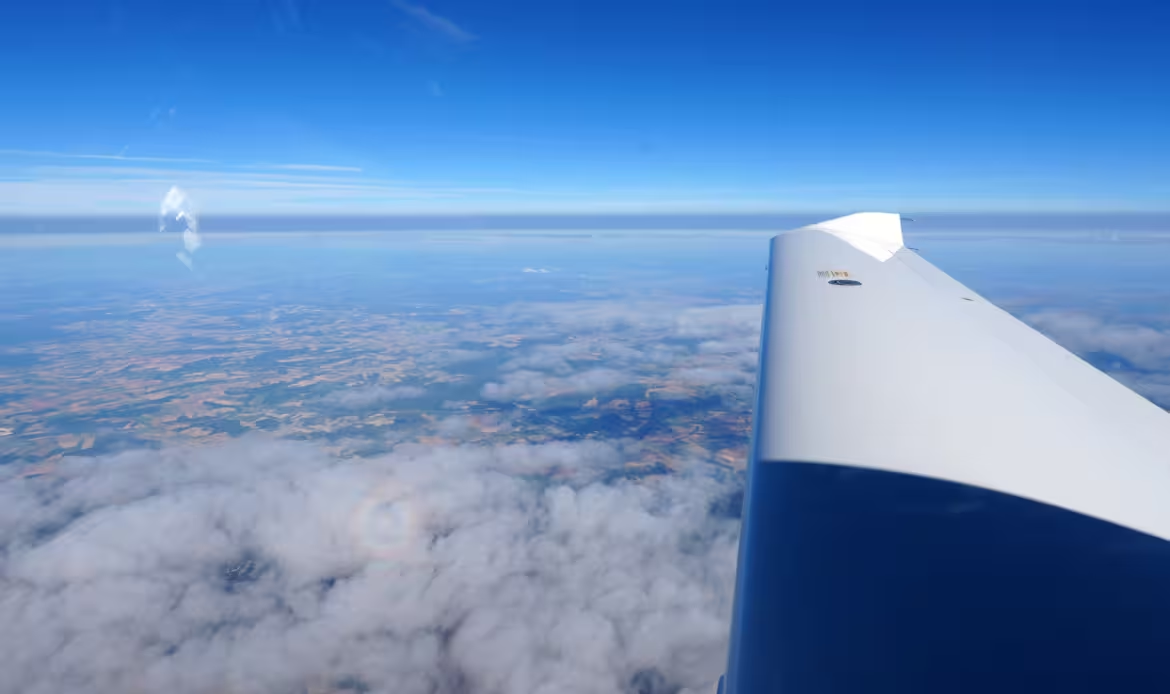
We asked ATC if we might descend at this point because there was some high-altitude weather that would most likely cause us to ice up, and while this was probably a precaution, I chose to descend to FL130 for the remainder of the flight. As is typical in this region, we are handed off in French airspace to London ATC, who will usually simply respond “Roger” or “Thank you.”
This can be useful since it gives you a decent sense of the weather, and to our surprise, a few airliners were dodging the weather on their way out of the UK, east of Detling VOR. To our surprise, we continued to observe the situation until we discovered VIRGA above us.
This was unusual because we didn’t expect airliners to avoid it, but it was indicating something major on their end, and some weather emerged on the Golze in the most recent update. We began our descent carefully before deciding to avoid that area of airspace and instead headed towards Southend, where the weather appeared to be clearer.
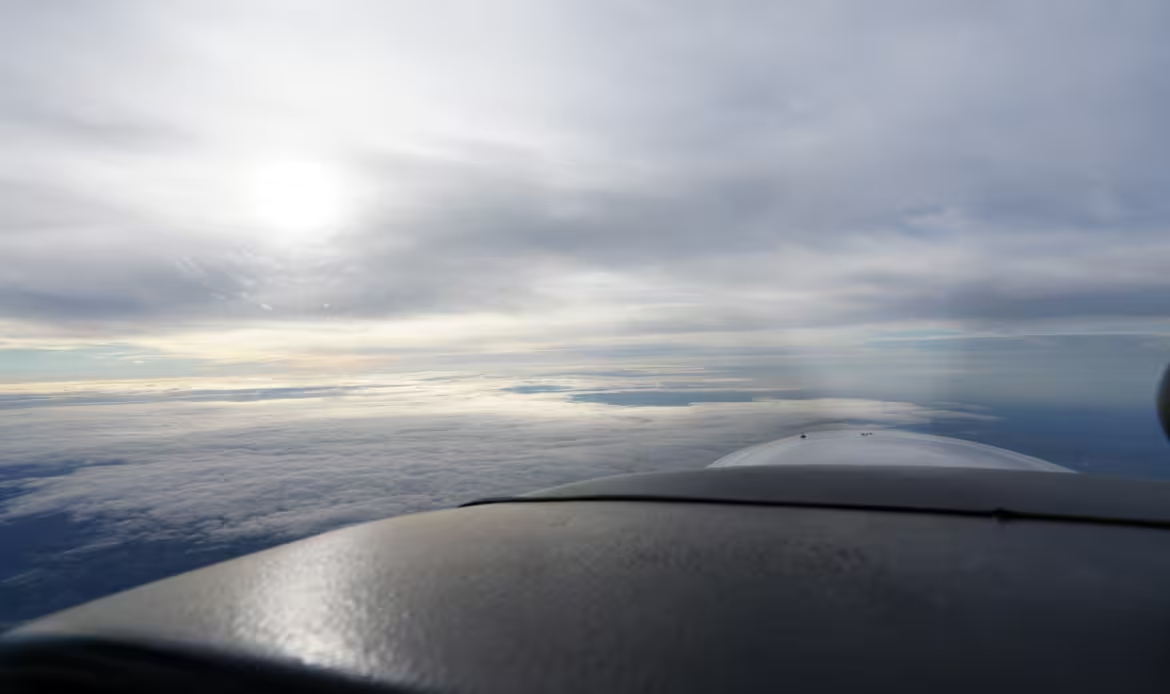
This came as a complete surprise, but with an occluded front, mid-level instability and convection are not implausible. We went via Southend Airspace, which had been NOTAM’d closed due to a lack of aircraft traffic.
Thames Radar initially controlled us, but as we descended, we were under the direction of London City Director rather than Thames Radar. This controller is rarely online, and it was the first time I had been on their frequency while inbound.
Because Stapleford had recently closed, we relied on the London City winds, and the coming frontal circumstances meant a small crosswind from the southwest, necessitating a landing on Runway 21L. We continued our descent, leaving controlled airspace and making a left-base approach to the airfield.
With the sun setting, the front arriving, and the possibility of my bed, home, and much-needed rest, we approached runway 21L, and the rather abrupt south-westerly breeze made for a bumpy approach.
After years of planning and multiple attempts to complete the trip, all of which failed for various reasons, the sense of success, despite a recent setback caused by a medical concern, was a relief to finally complete the trip. We landed in Robbie fashion, exited the active runway, returned to our usual parking spot, and enjoyed the fresh air of the UK, not.
ATC Flight plan and route flown –
N0130F160 MEN A27 MOU B373 TRO G40 VATRI B3 RINTI L10 DVR/N0129F130 L6 DET
Filed ATC flight plan for LFMT-EGSG
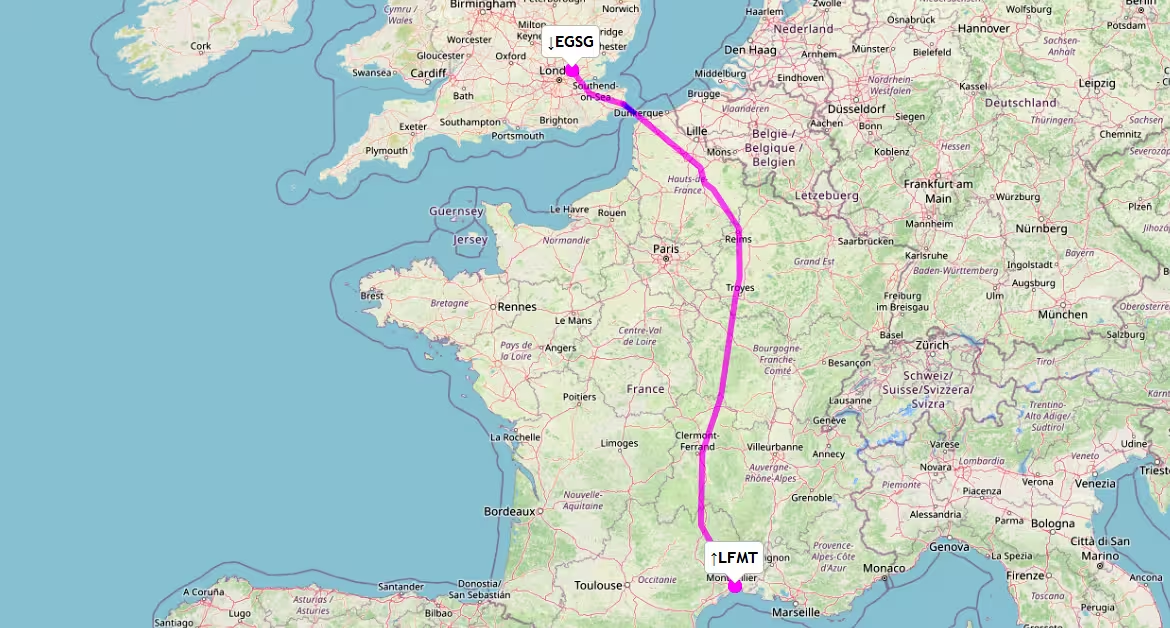
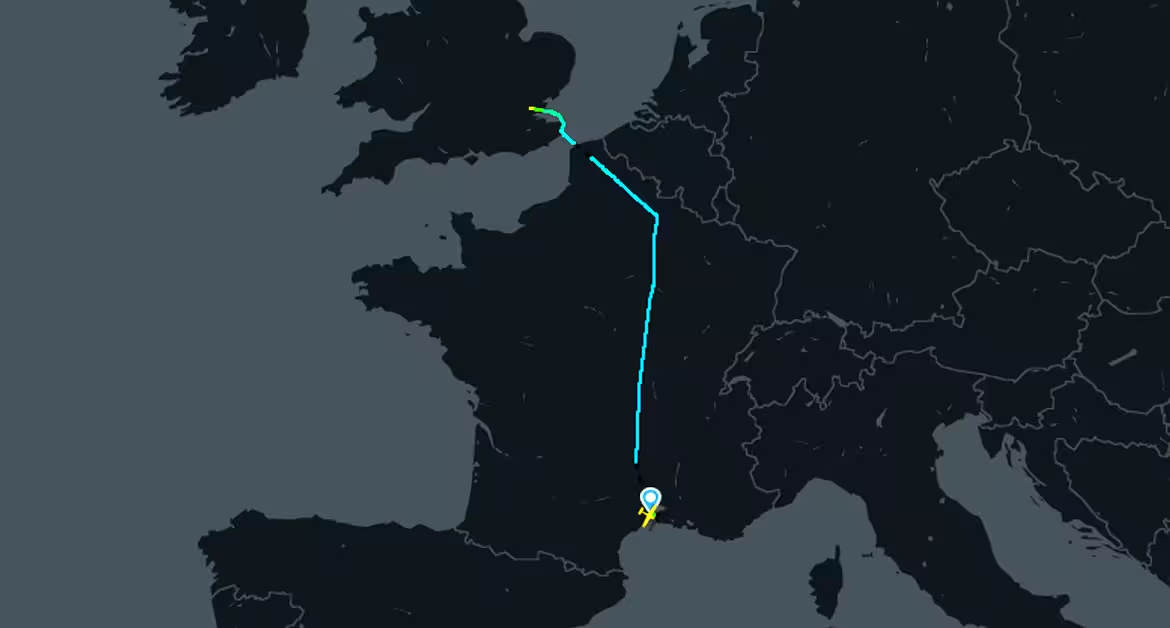
Outcome & Costs –
This was a trip that I never imagined would happen, from the complexities of navigating the intricacies of Spanish airport politics to the trip of a distance in an environment so far from my comfort zone – so much could go wrong, yet it didn’t, because of the perfection of my planning, the assistance of those familiar with the processes involved with El Cheapo, and ultimately my willingness to fly this trip IFR, and the result was simple.
While staying in Ibiza and partying to your heart’s content isn’t inexpensive, the fact that I did it will perhaps motivate others to follow in my footsteps, knowing they accomplished what others claimed was impossible.
Ibiza Airport Costs –
The final bill was split into the following;
AENA Fees
- Landing €12.88
- Service Air Traffic of Airport – €6.71
- Landing COVID Recovery – €0.37
- Parking Charges (6 nights) – €34.70
- Parking COVID Recovery – €0.65
- Met Services – €0.21
- Met COVID Recovery – €0.0
Sub-Total: €67.18 (Paid via AENA POS £58.47)
Iberia Fees
Landing 12.88 EUR (Paid via SEPA £16.65)
- Minibus between aircraft and commercial aviation terminal – €6.71
- Minibus between commercial aviation terminal and aircraft – €6.71
Sub-Total: €18.86 (£16.65)
Total Costs Ibiza: €86.04 (£75.12)
Jet A1 Uplift: €160.96 (£139.98 (73 Litres) @£1.91 litre
Sub-Total: £215.10
Ibiza Costs –
Food, Drink & Leisure Costs: £638.37 (Food/Taxi’s split amongst us)
Accommodation Costs: £70.25 per night per person
Total Accommodation Costs: £421.51 (Room – £843.02)
Travel Costs: £21.77 each way (Est) – €25.00
Sub-Total: £1059.88
Montpellier Airport Costs –
Jet A1 Uplift (first tech stop): €260.02 (£226.31 (121 Litres) @£1.87 litre
Jet A1 Uplift (second tech stop): €152.58 (£132.80 (73 Litres) @£1.81 litre
Landing Fees: Stop off on the 23rd of September for less than one hour and on the 28th of September for 90 minutes for a refuel. Quick service, had to pay by cash on the way to Ibiza and paid for Jet A1 by Visa Debit on the way back.
The fee comes as a FORFAIT JOURNÉE ET JOUR SUPPLÉMENTAIRES/ DAYS PACKAGES and totals EUR 29.28 (£25.82) for both movements in and out.
All arranged via pce(at)montpellier.aeroport.fr
Flying Costs –
Aircraft Charges: £2,913.36 (@ £183 per hour (15 hours 55 minutes flown))
Airport Fees: £100.94 (As above)
Oxygen Refill – £20.75
JetA1: £499.09
(Wet Rate drawback) Credited £250.44 (-) (GZANY) (267 litres at EGSG rate) xxx
Total Cost –
Total Costs (Non-Aviation): £1059.88
Total Costs (Aviation): £3283.7
Total Costs (All): £4343.58
Version 1.1 – Last Updated 12/10/2024
Aircraft –
The aircraft is a DA40 TDI, which uses a Thielert “Centurion” 135 hp (101 kW) diesel engine and burns diesel or jet fuel. It has a constant-speed propeller and FADEC (single lever) engine control. G-ZANY is based at Stapleford Aerodrome, Essex, UK and was delivered as new in 2003.
Read more about the aircraft on the dedicated page
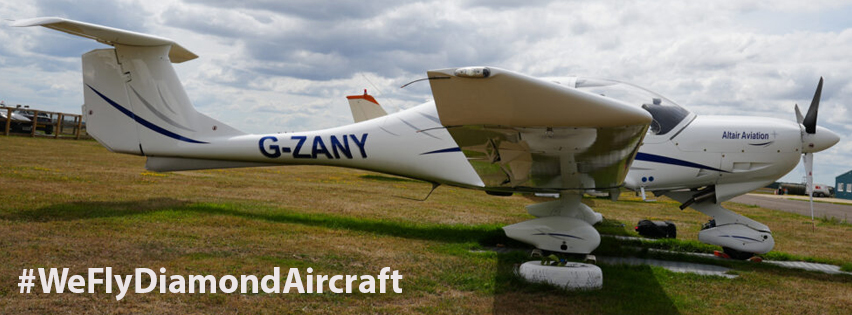
Supporting the YouTube Channel –
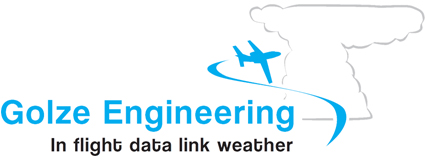
Support the YouTube Channel –
Welcome to The FLYING VLOG…
I am a current PPL(A), SEP (LAND), IR(A) SE/SP PBN, IR(R) & Night holder. Flying the world, exploring its hidden treasures. Taking pictures and vlogging the journey; I hope I can provide you with an oversight of my progression as I develop my skillset and airmanship in exclusive videos on my YouTube channel.
Now flying IFR in the Airways of Europe & beyond. Bringing you an exclusive niche to YouTube, flying in the same skies with commercial airliners.

